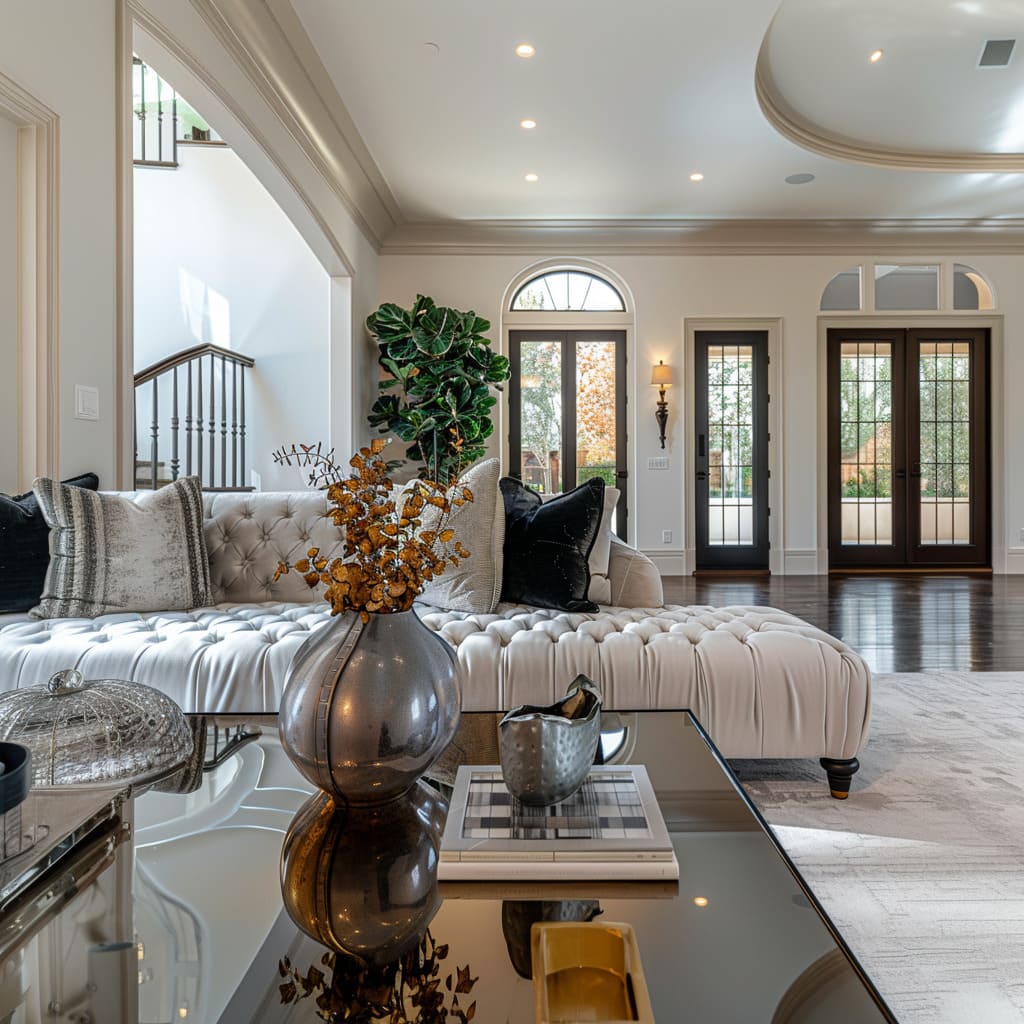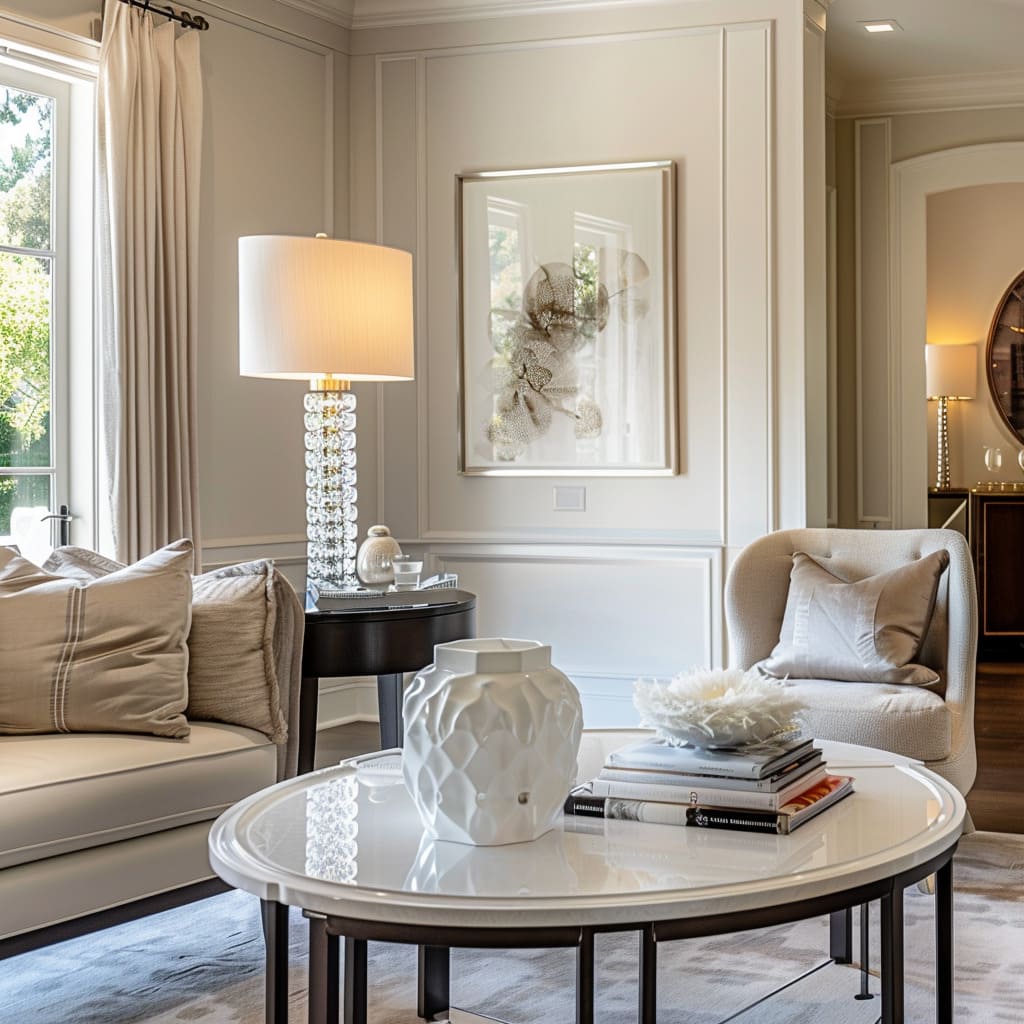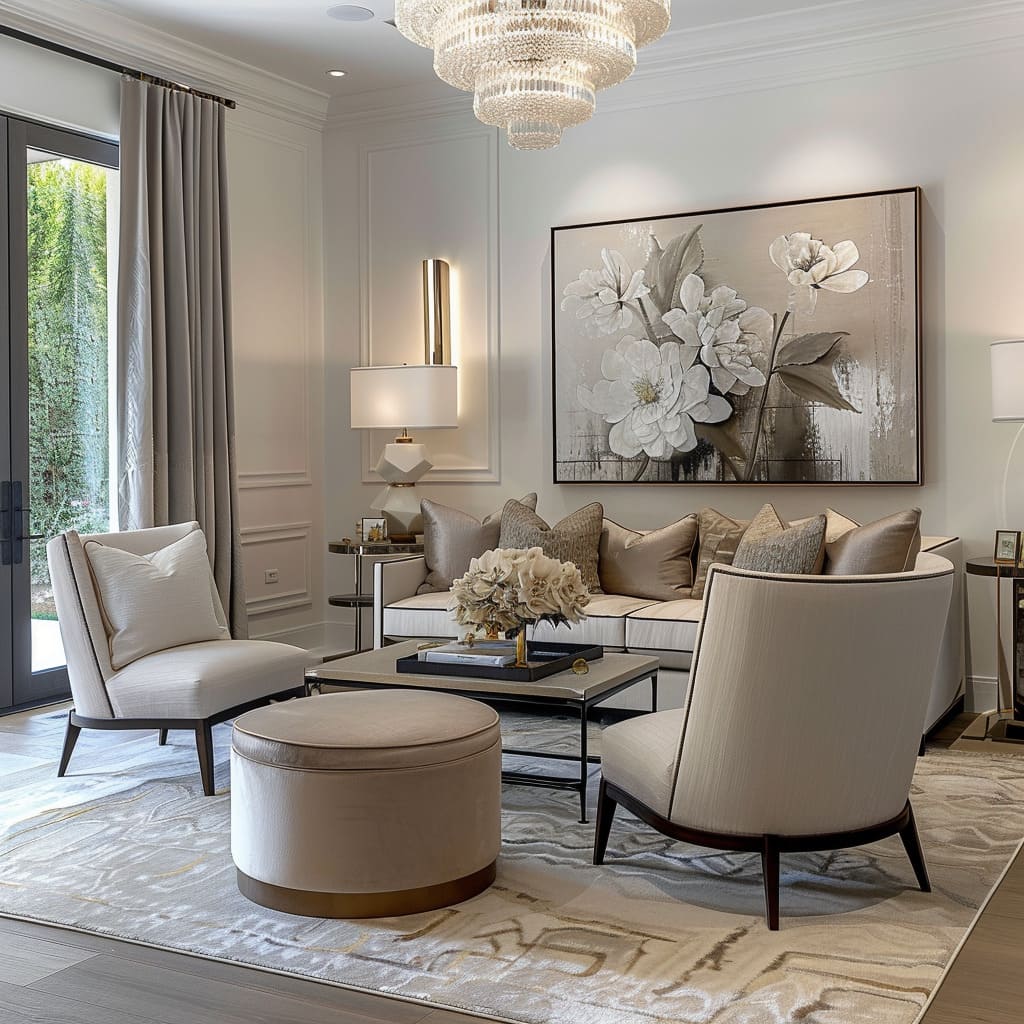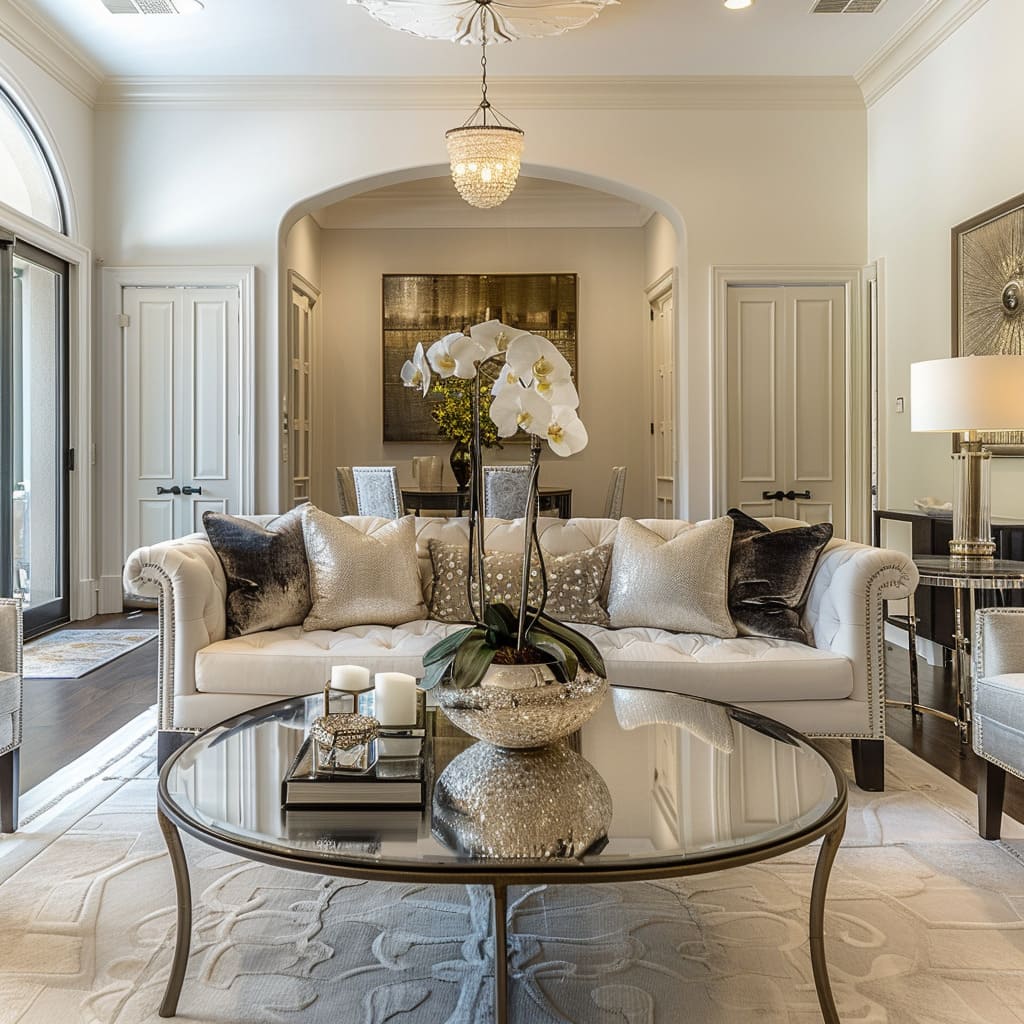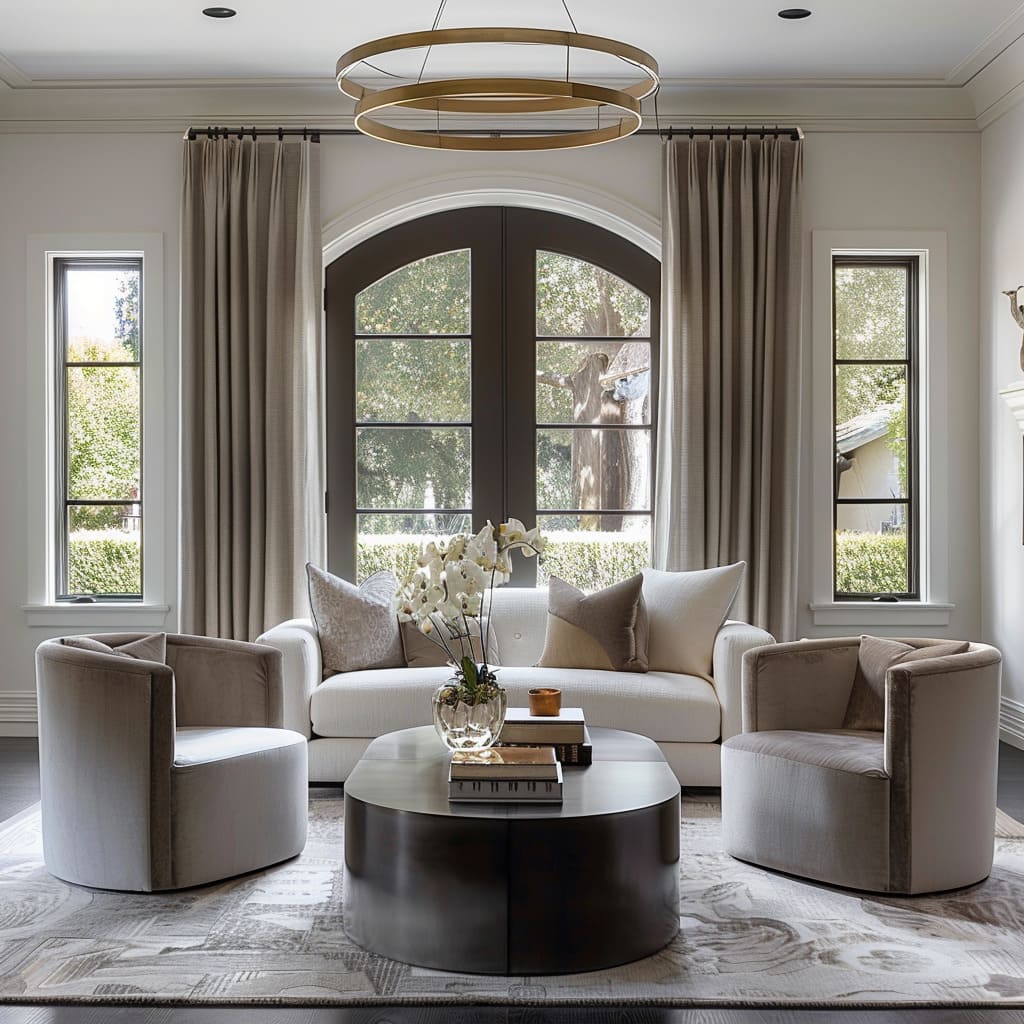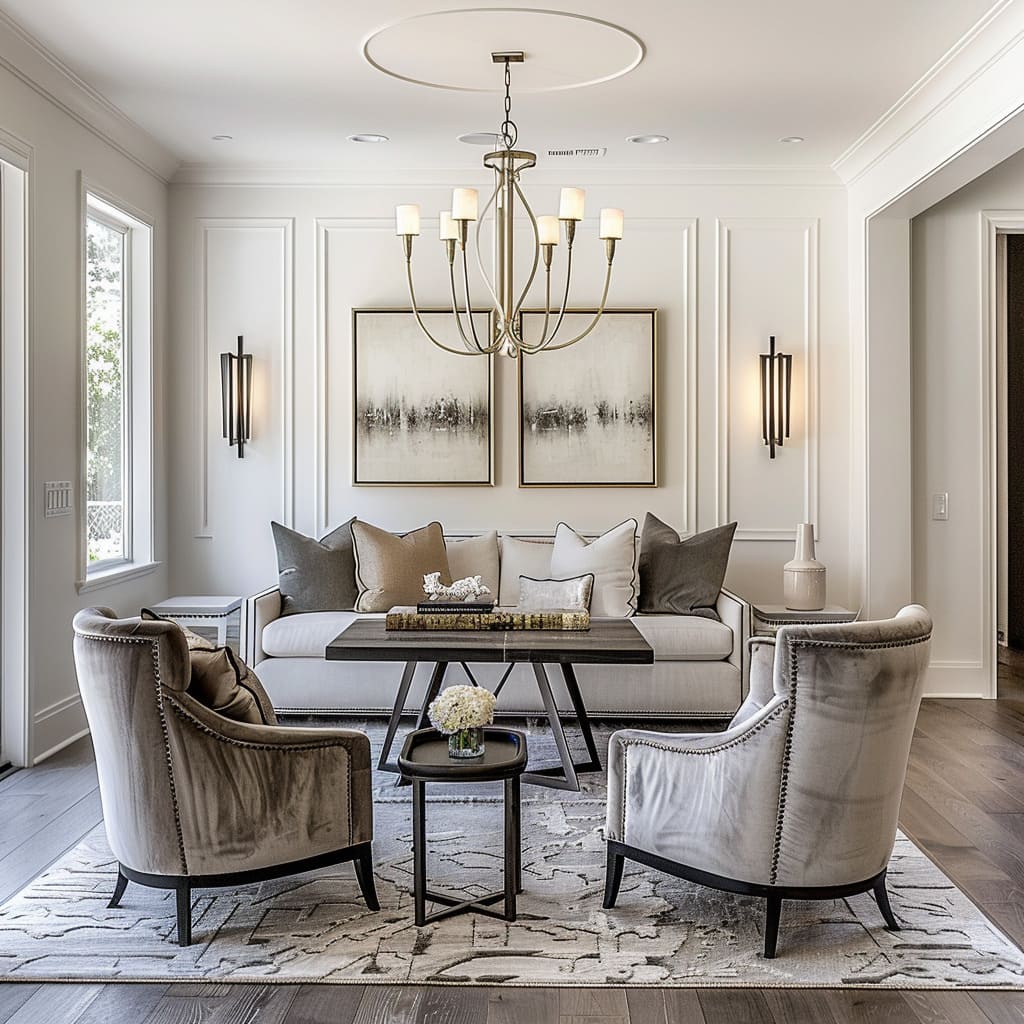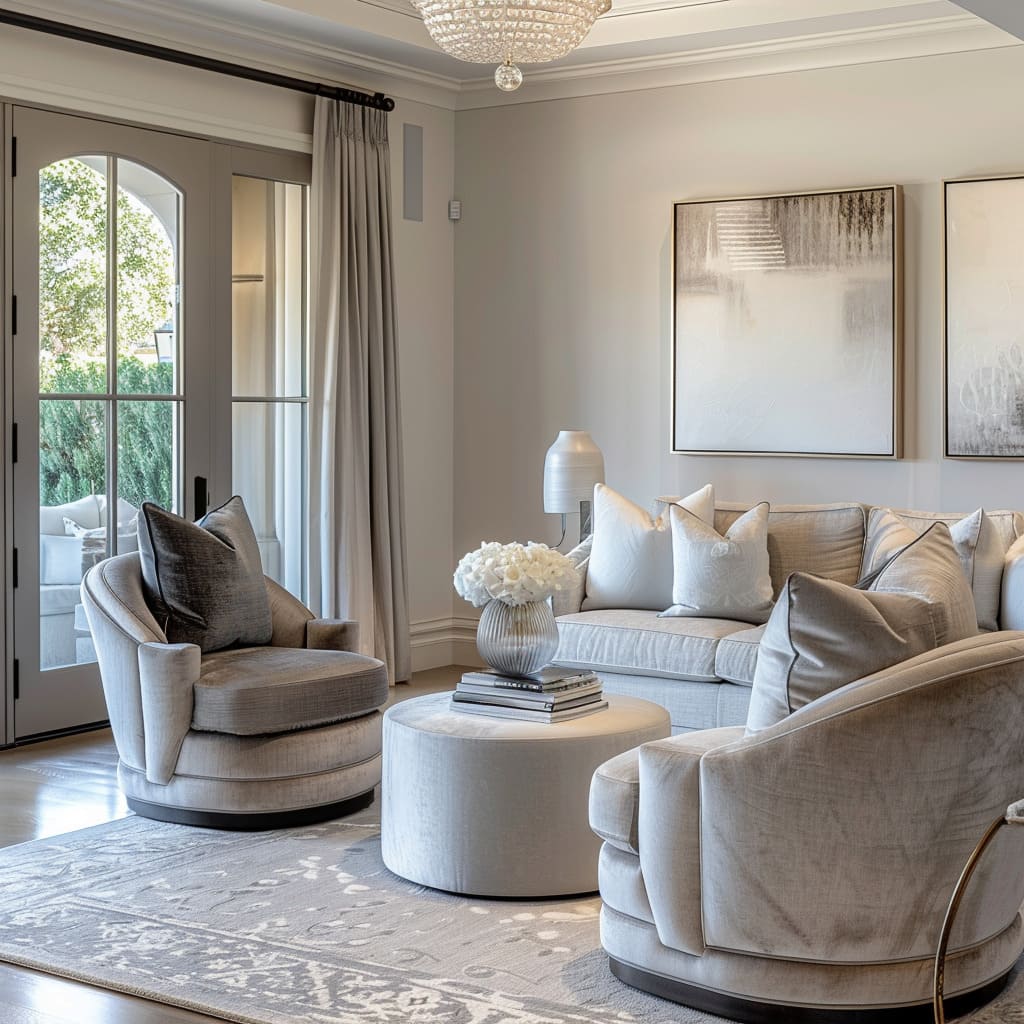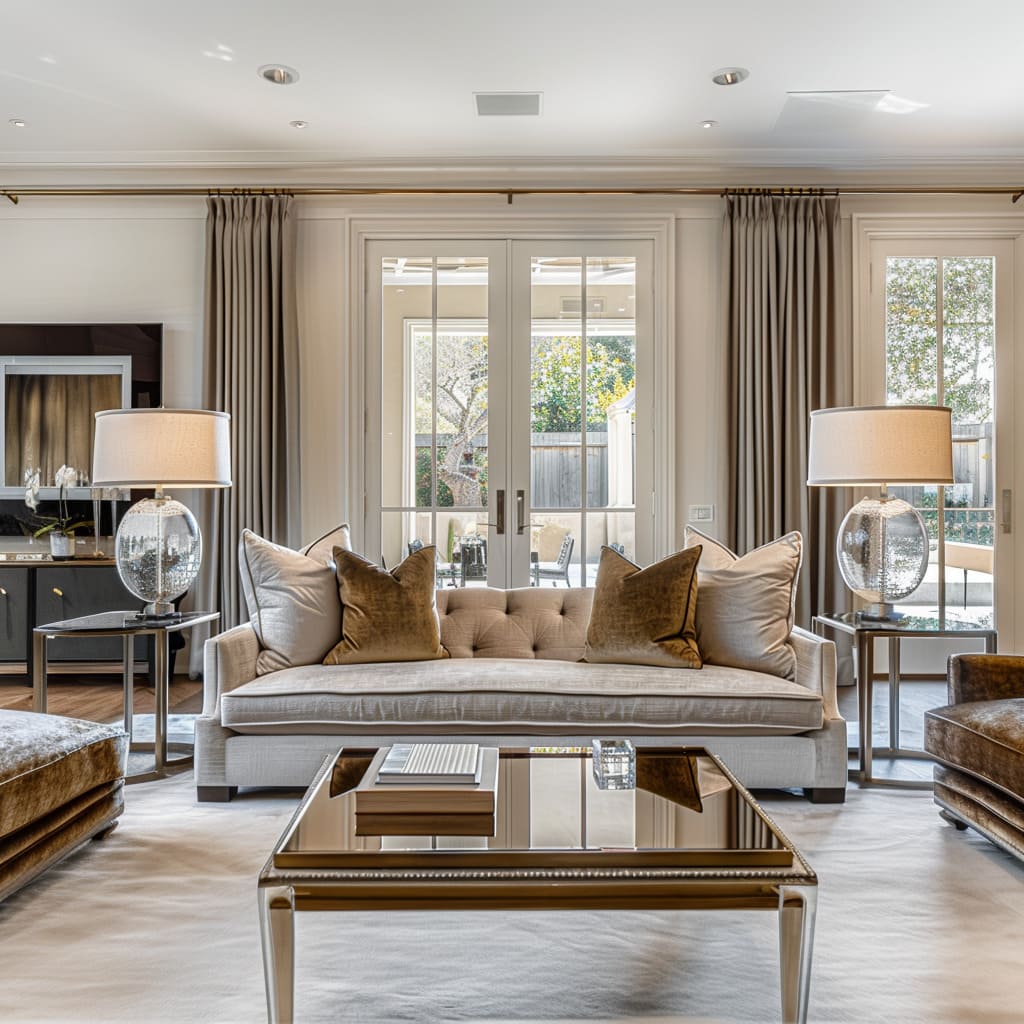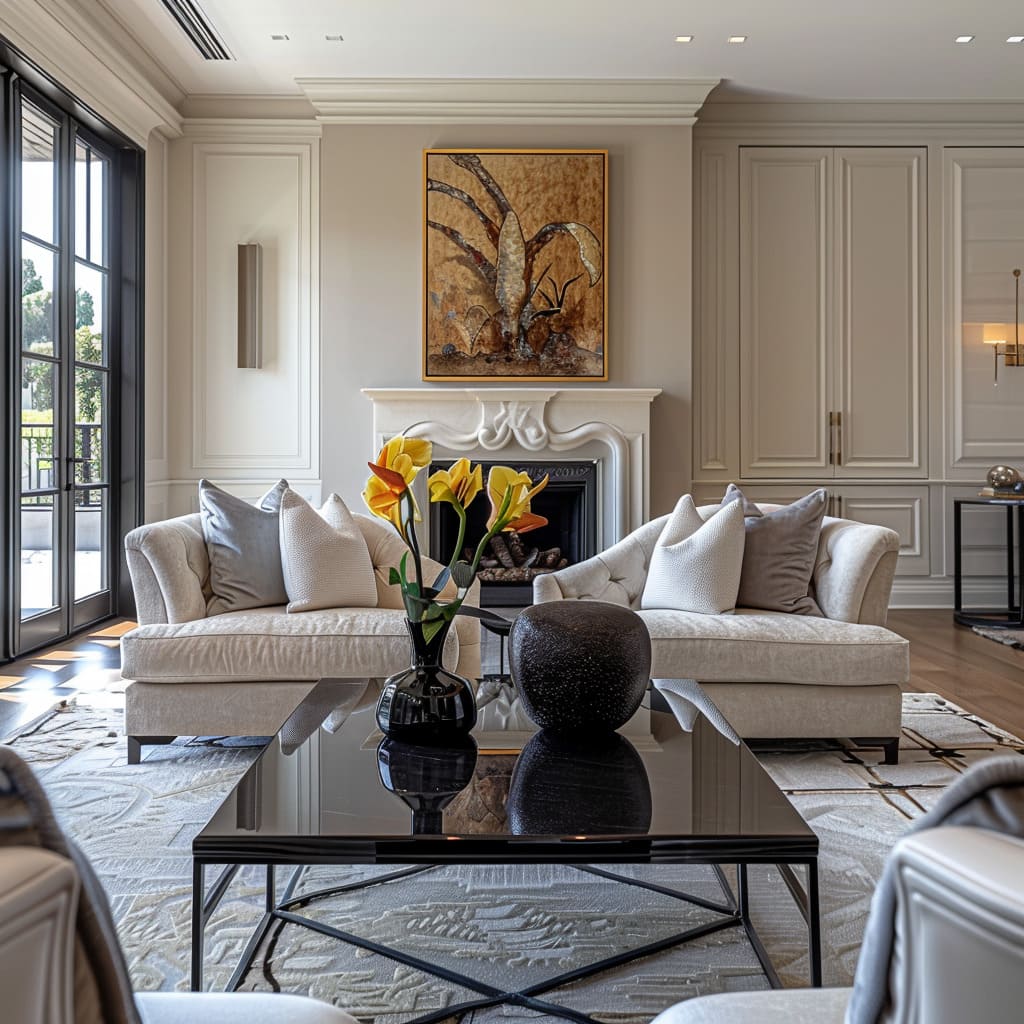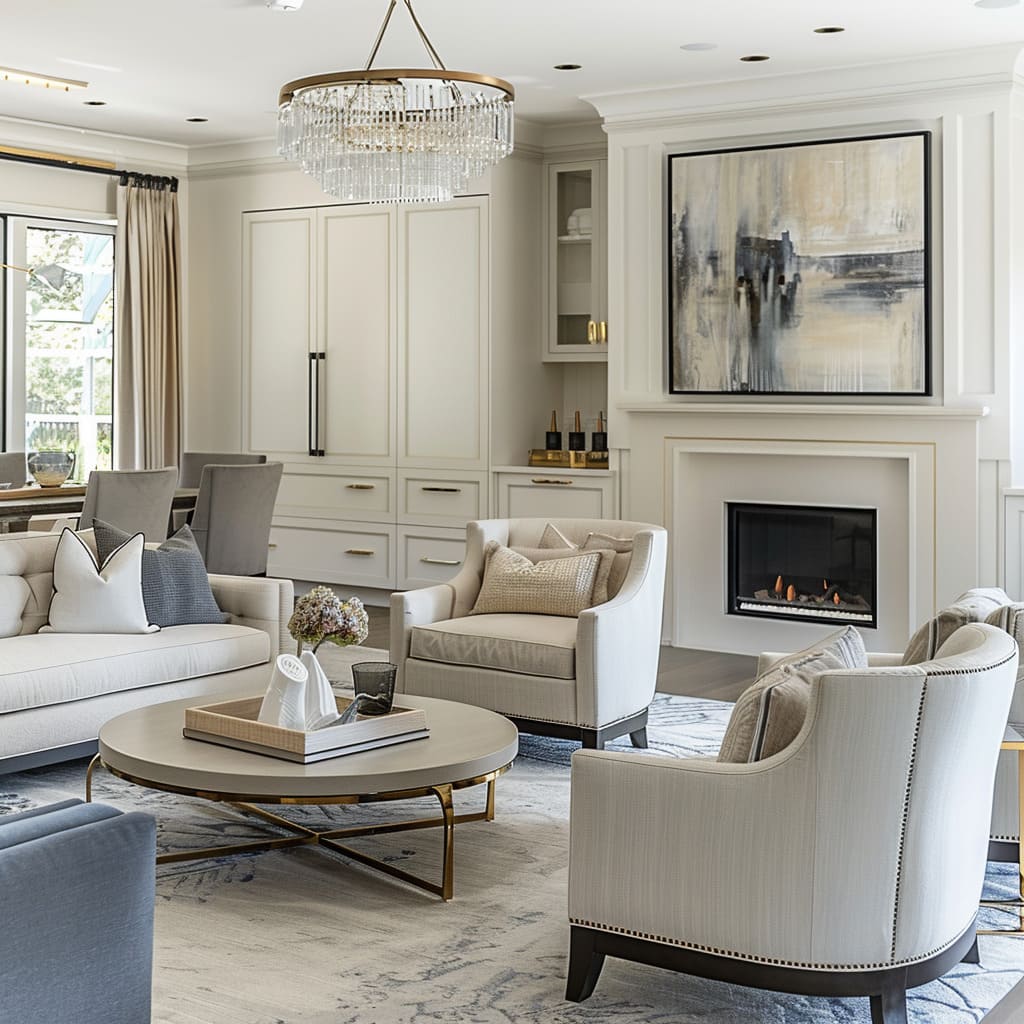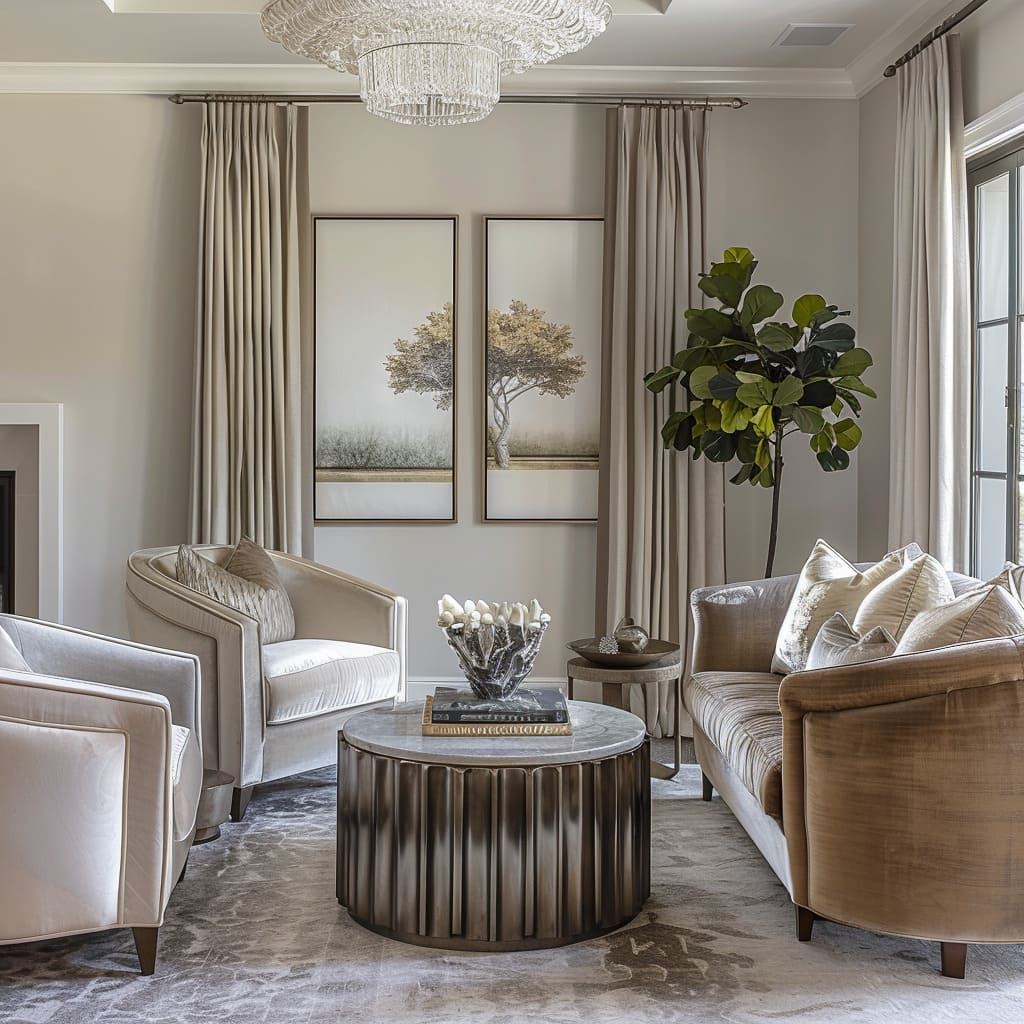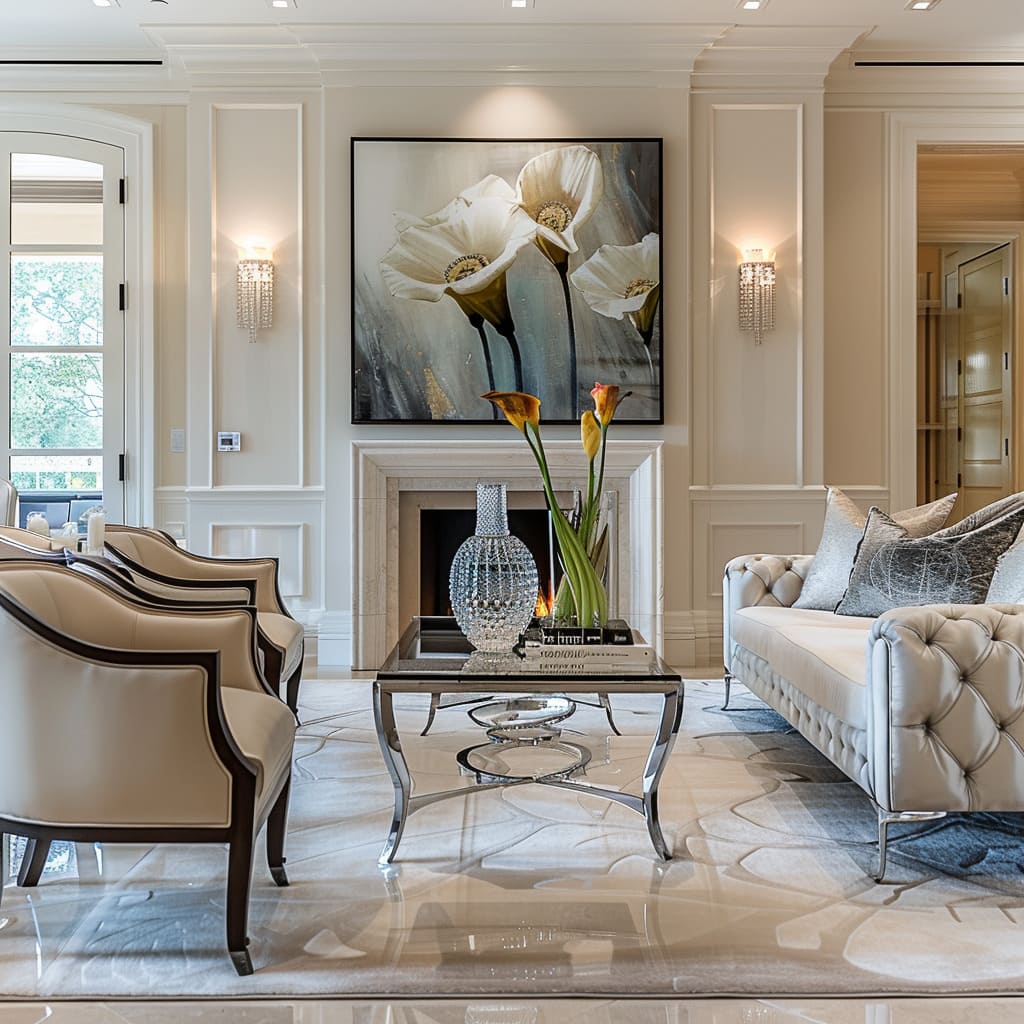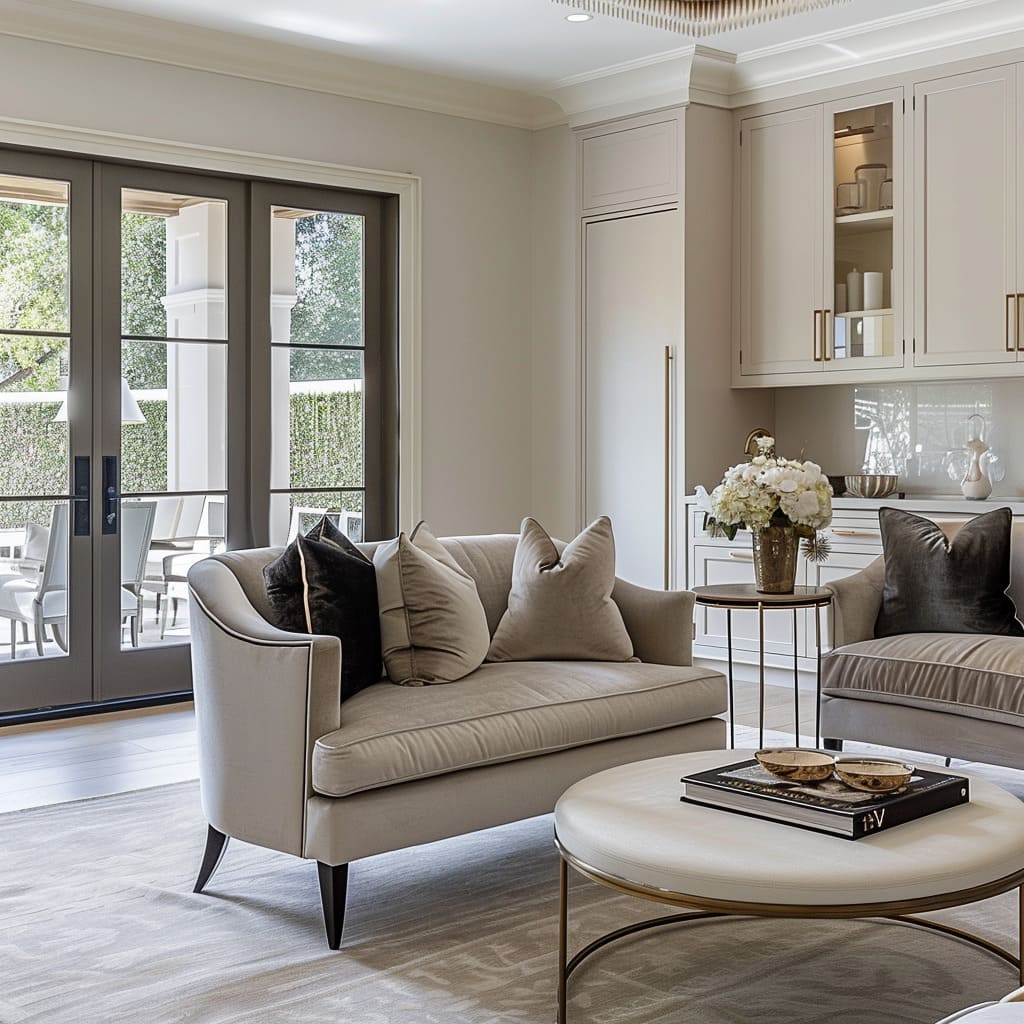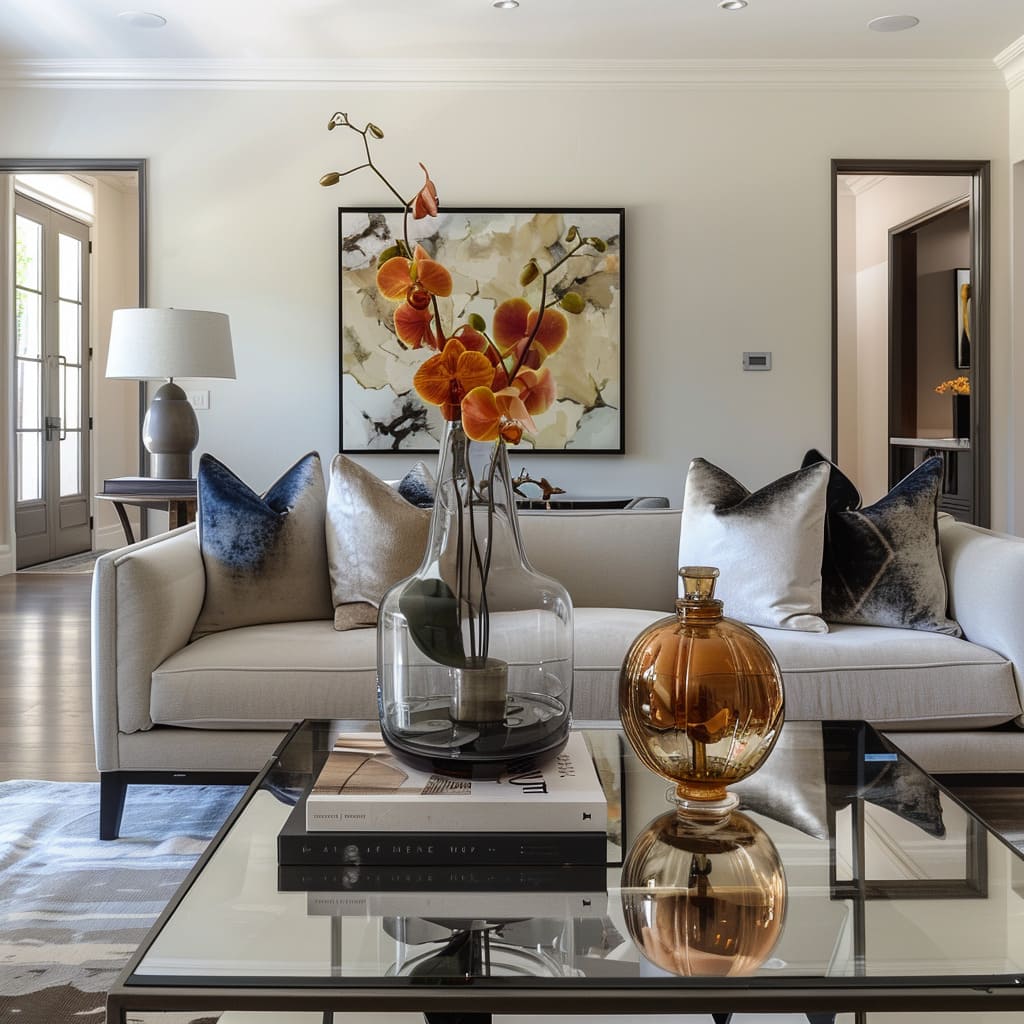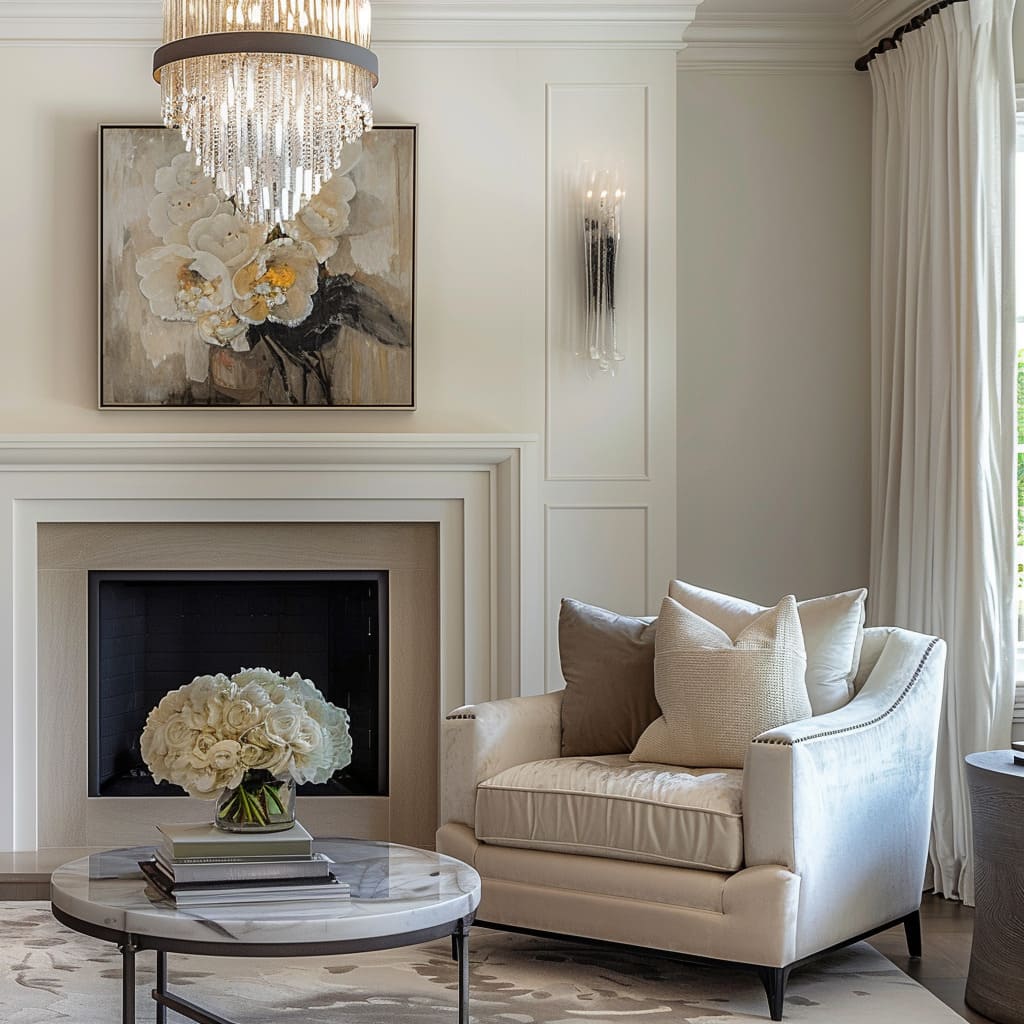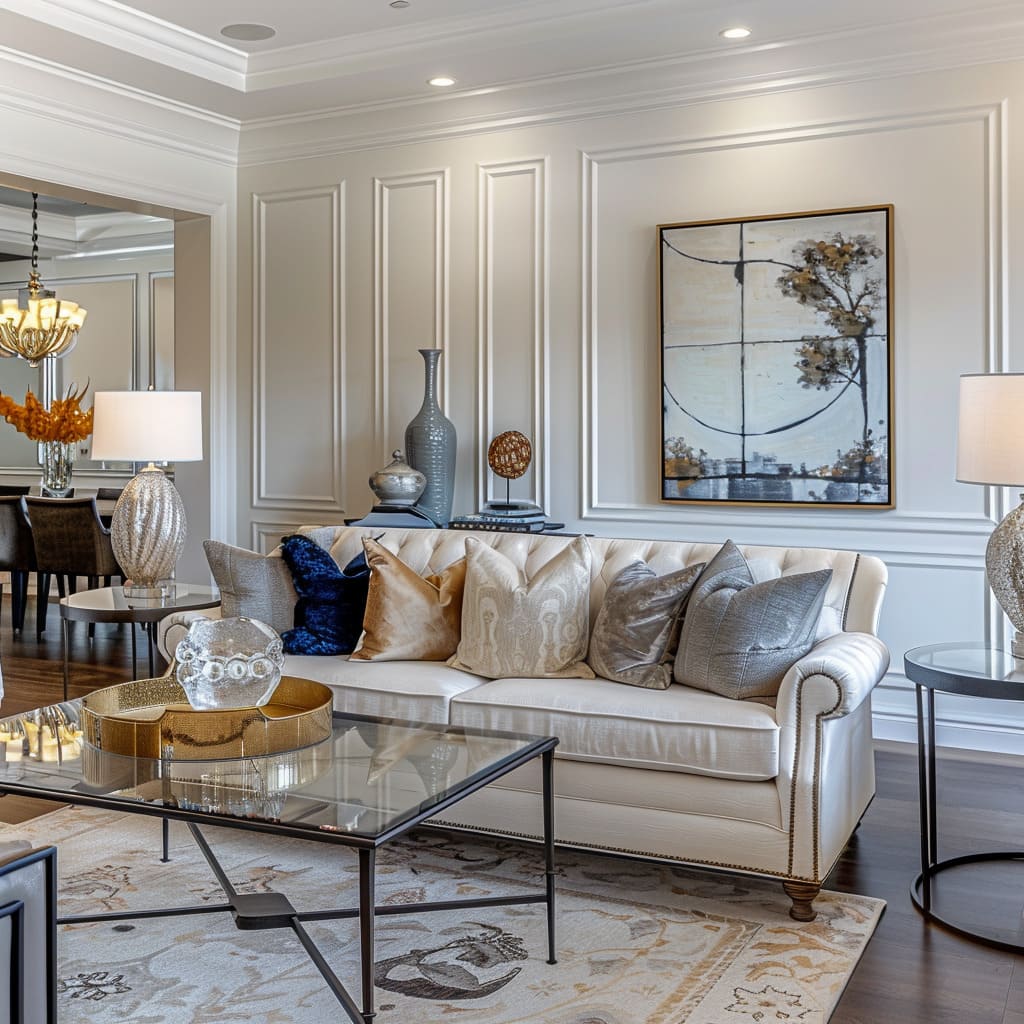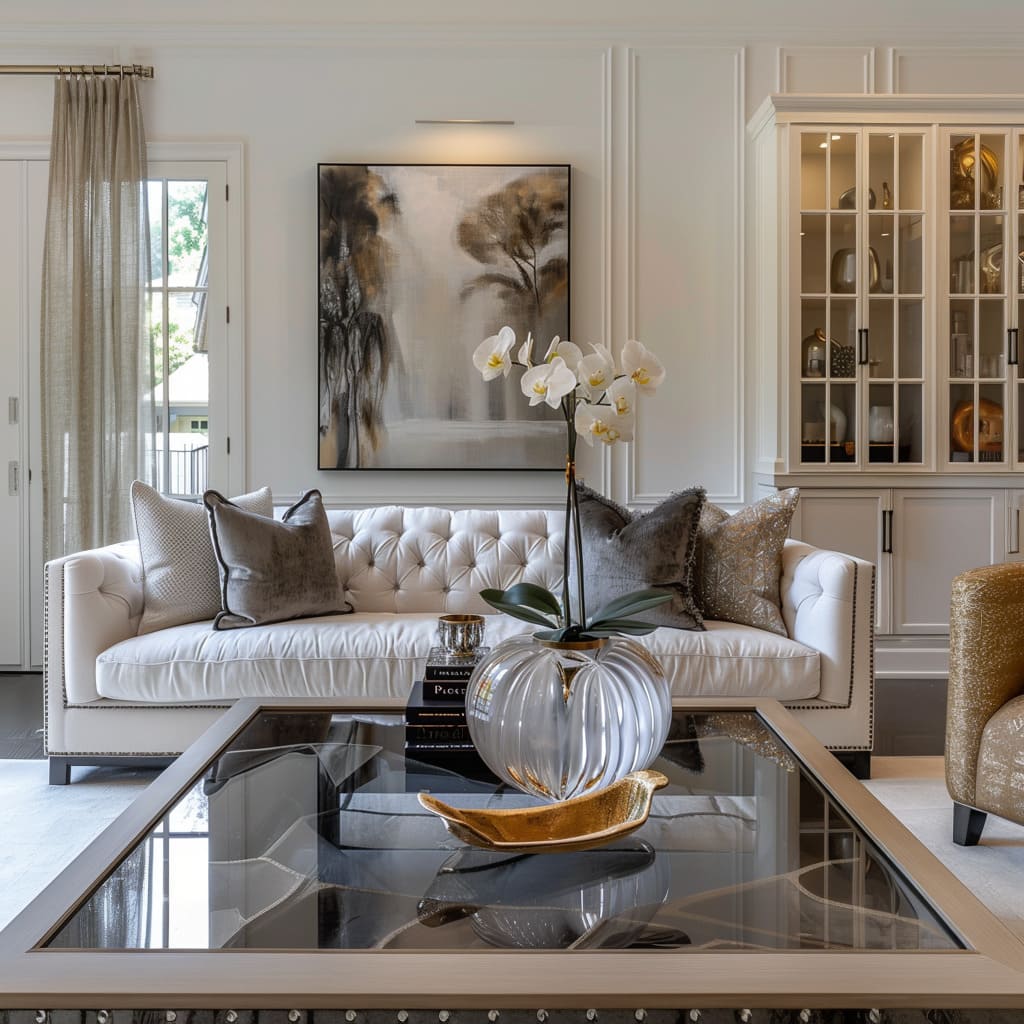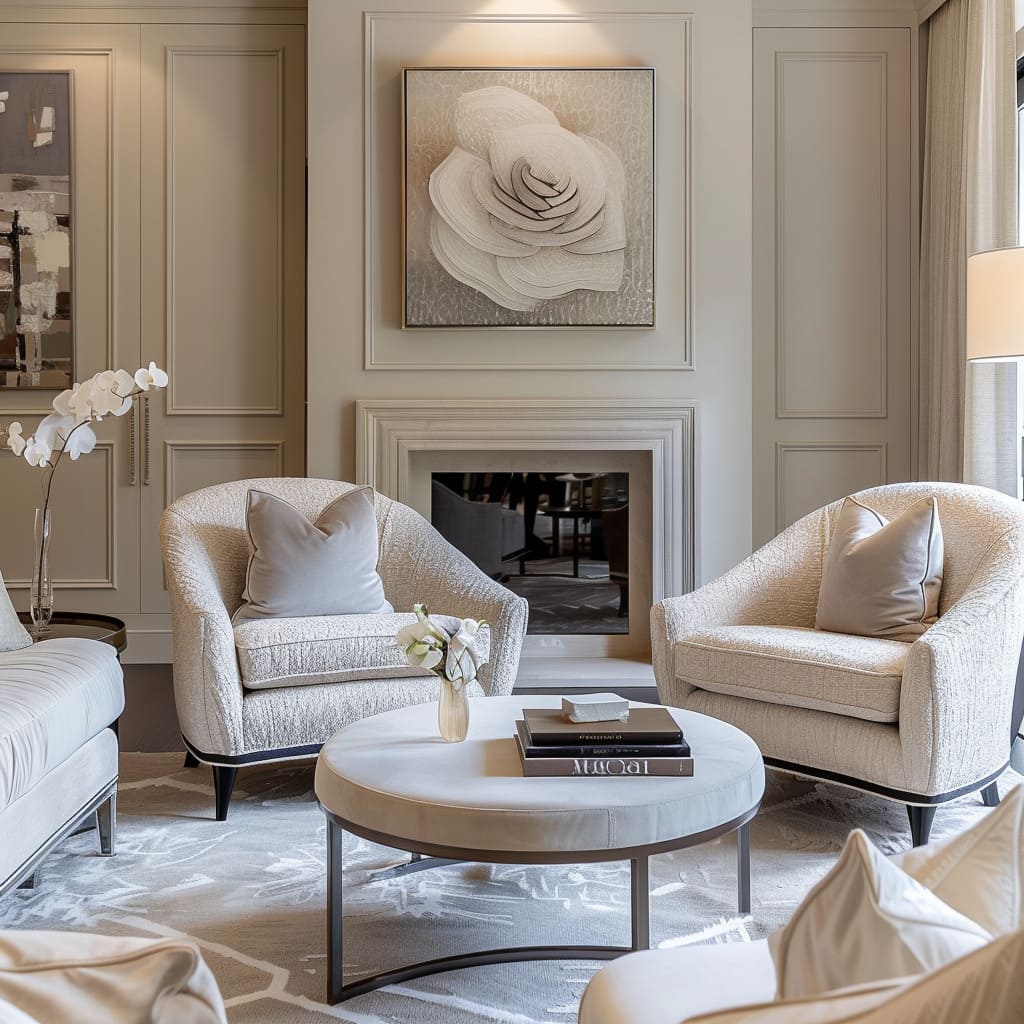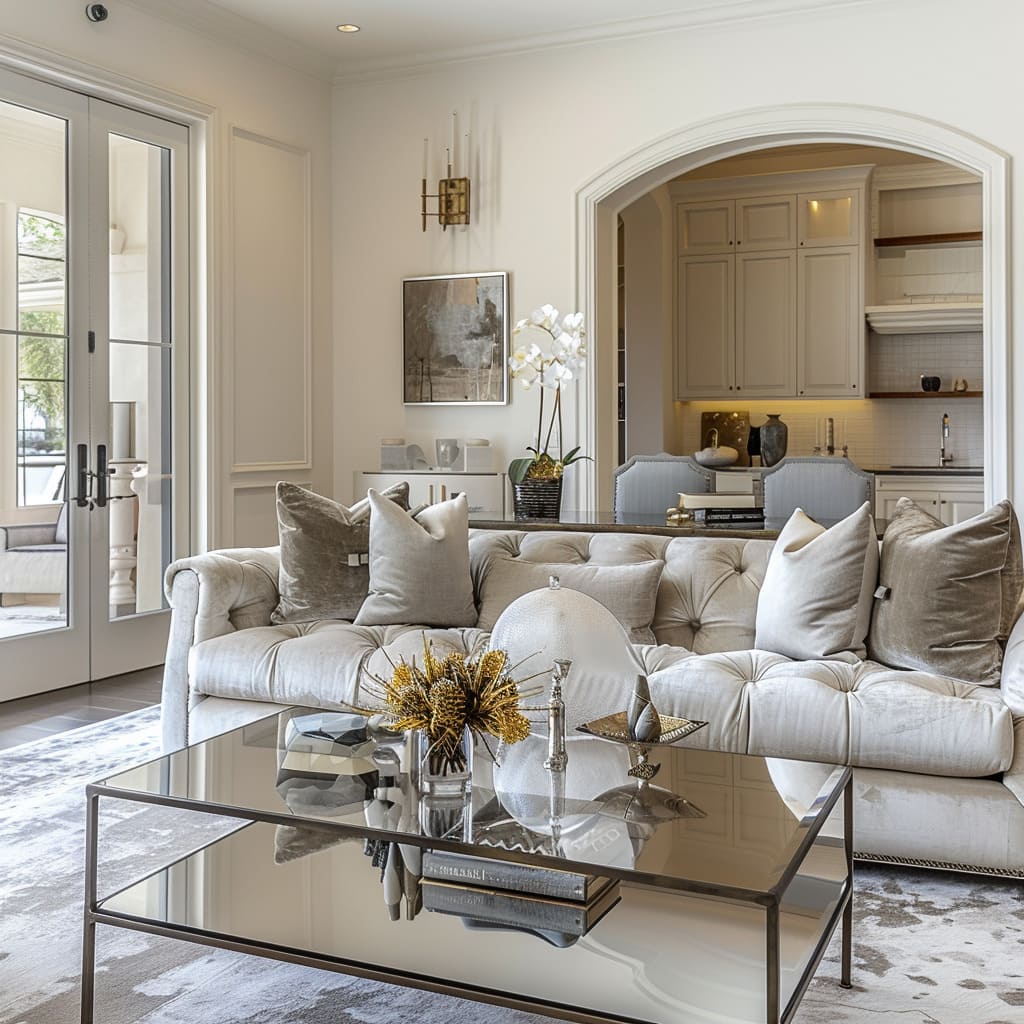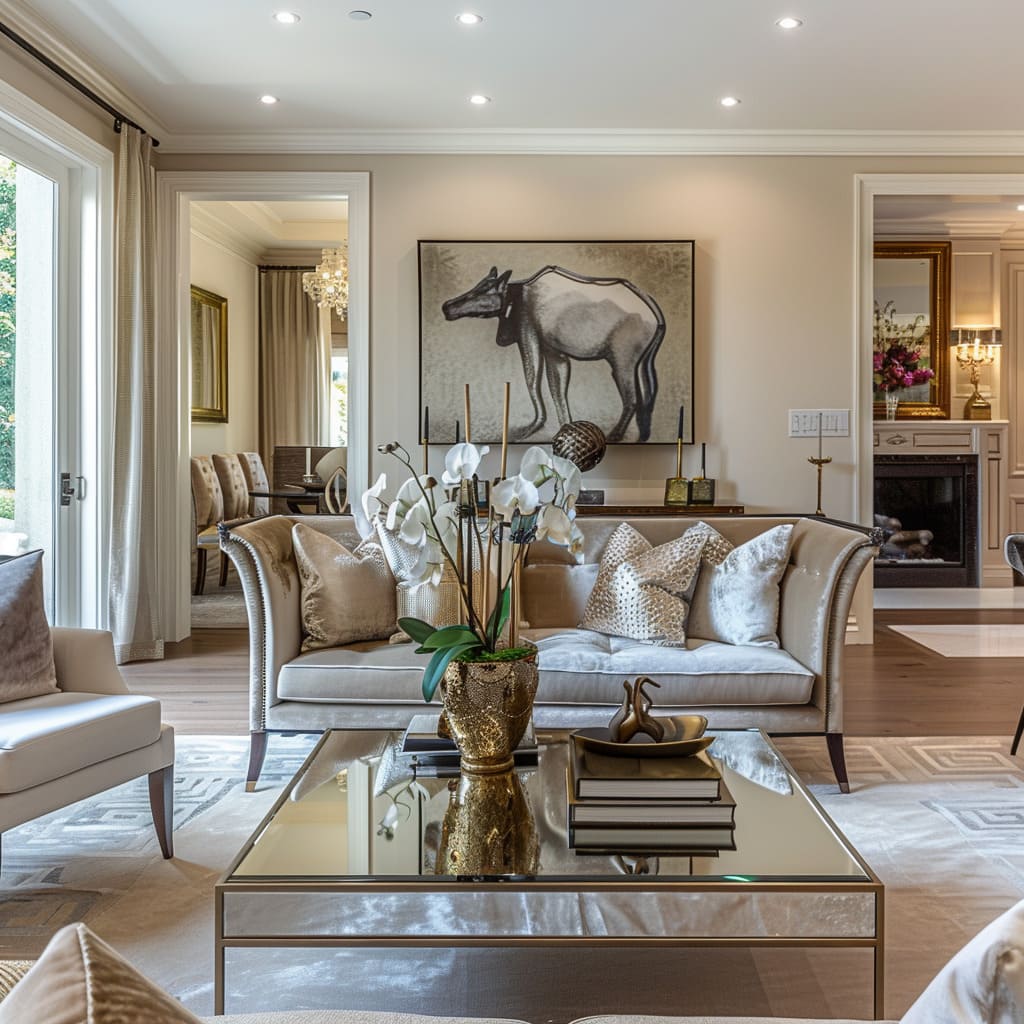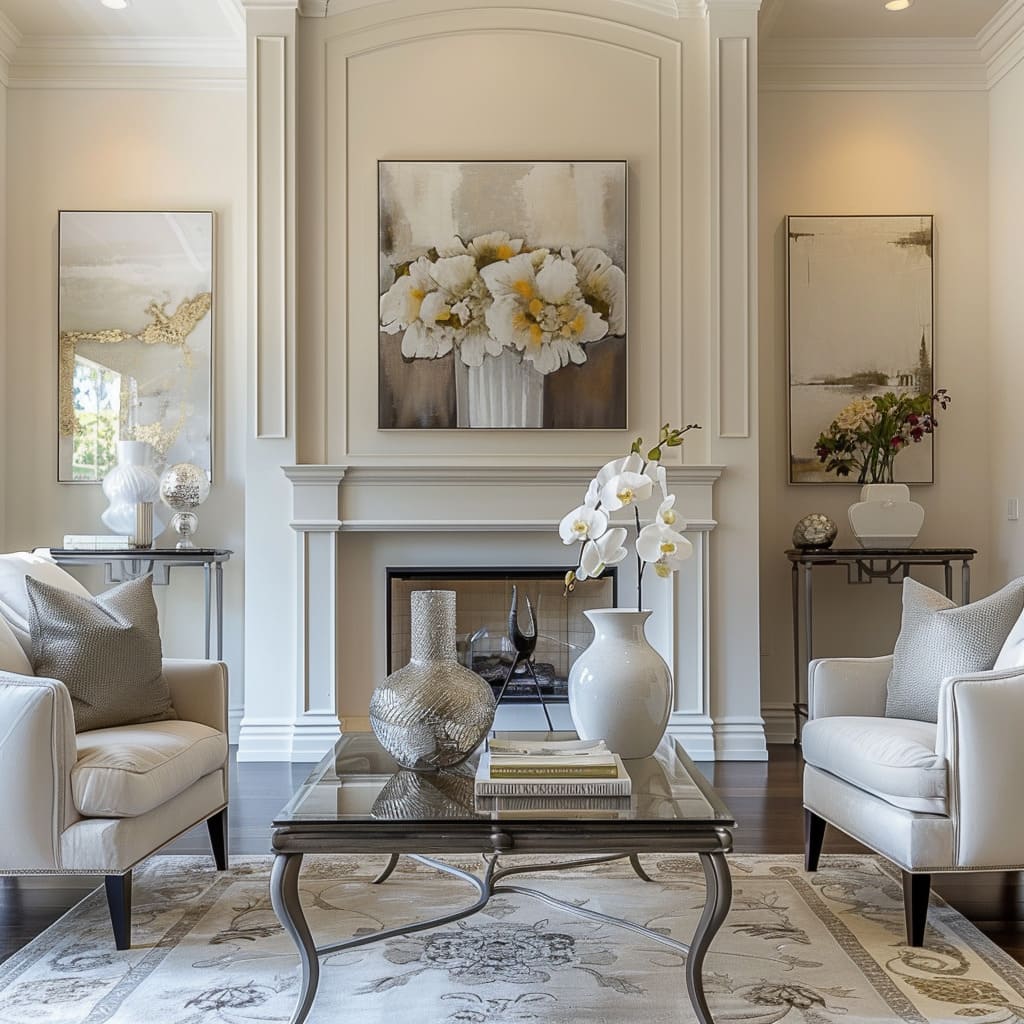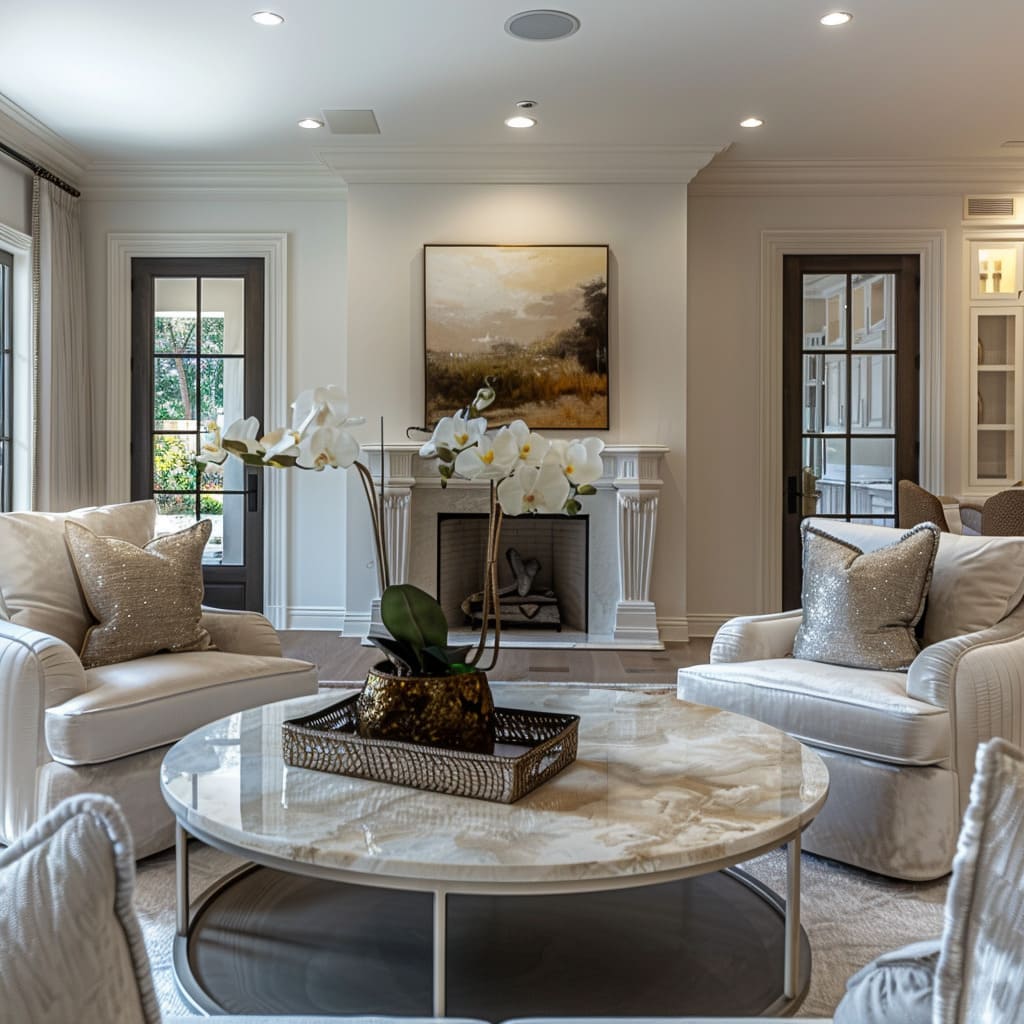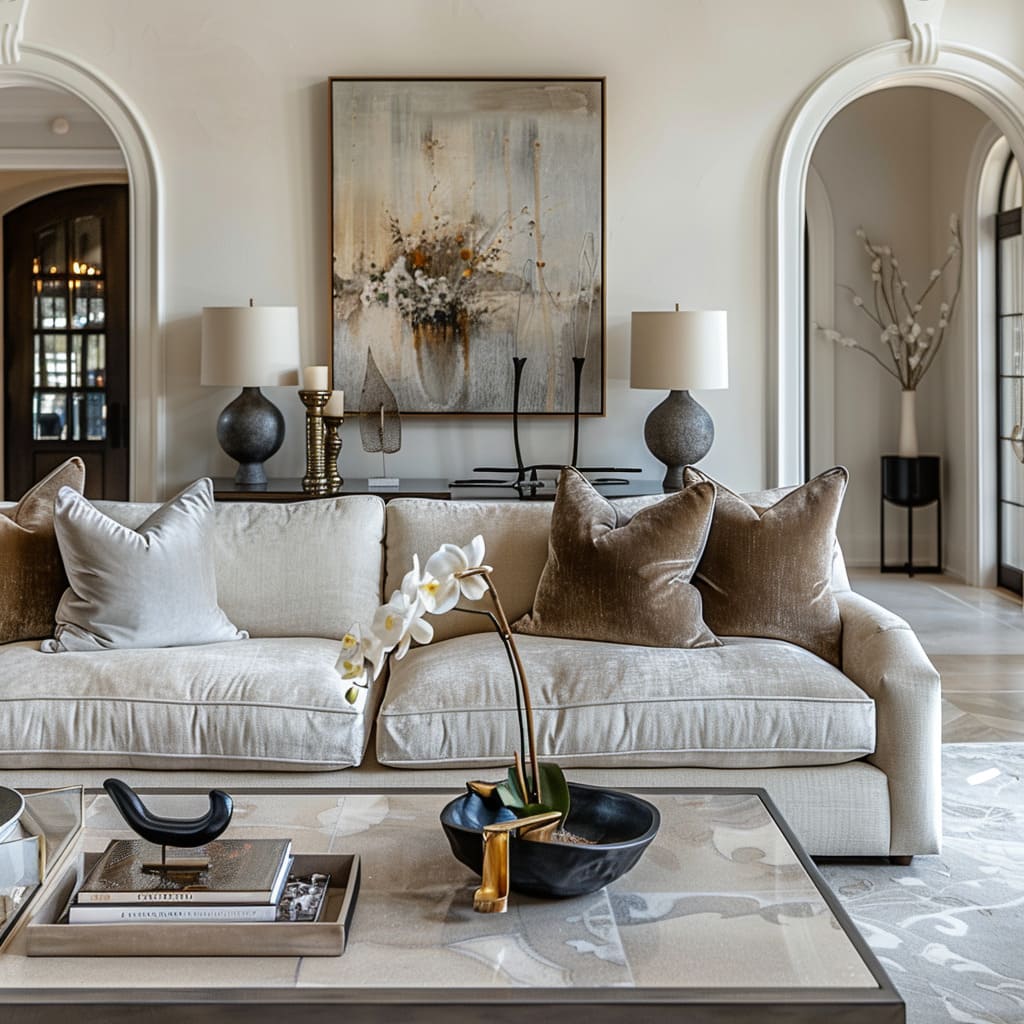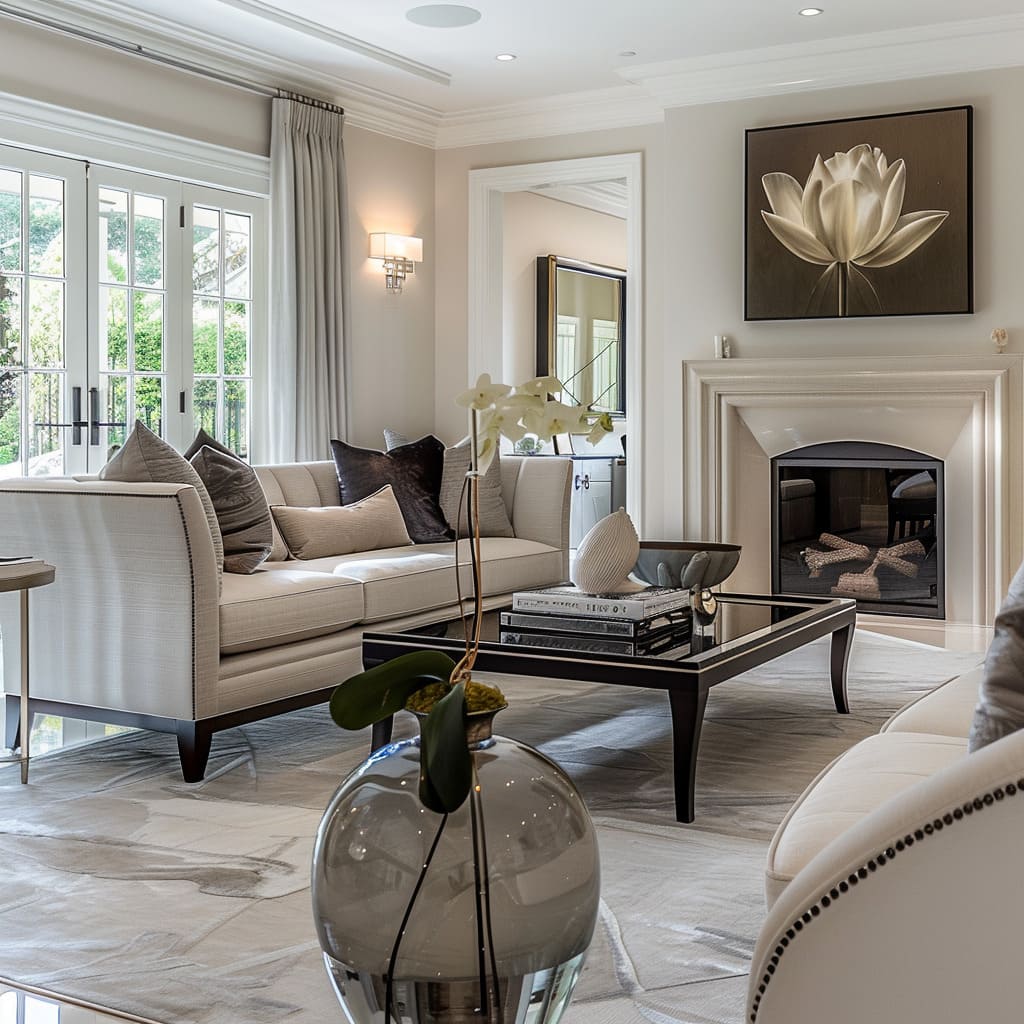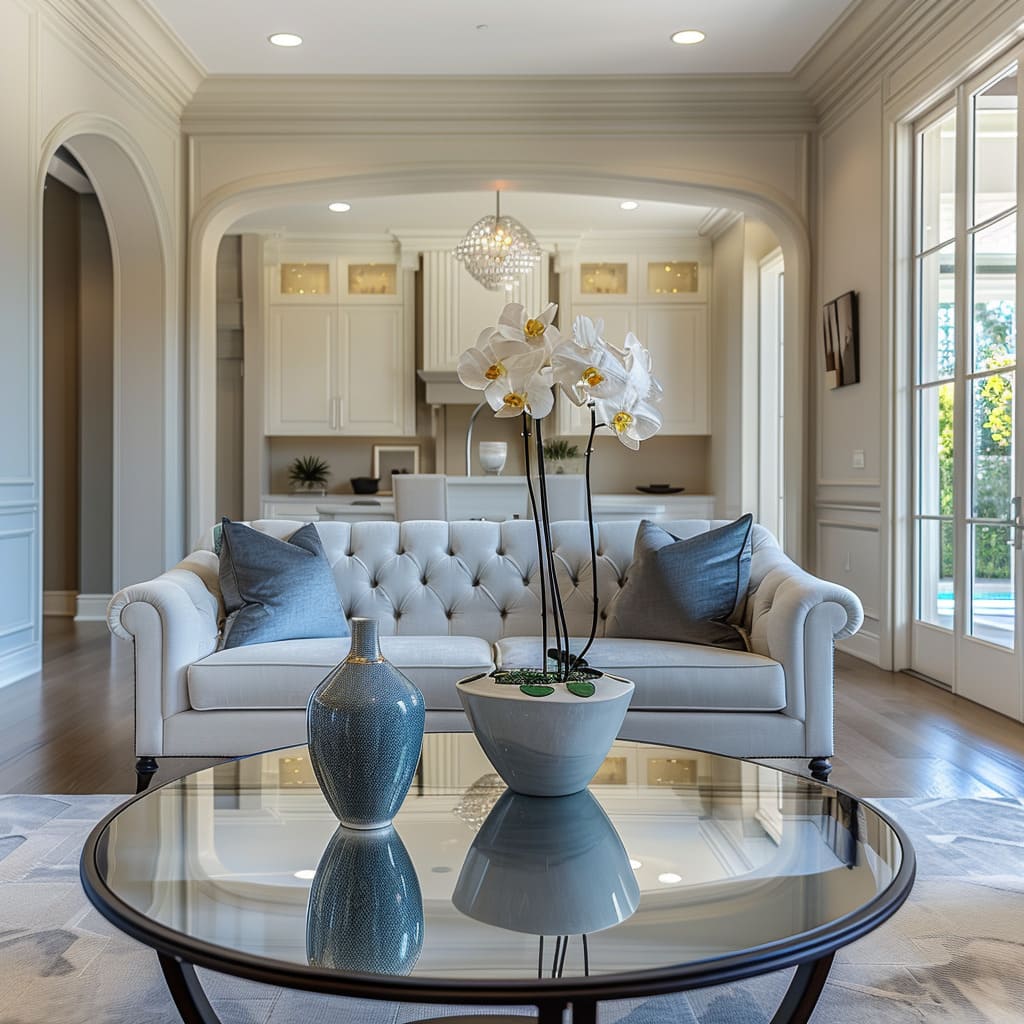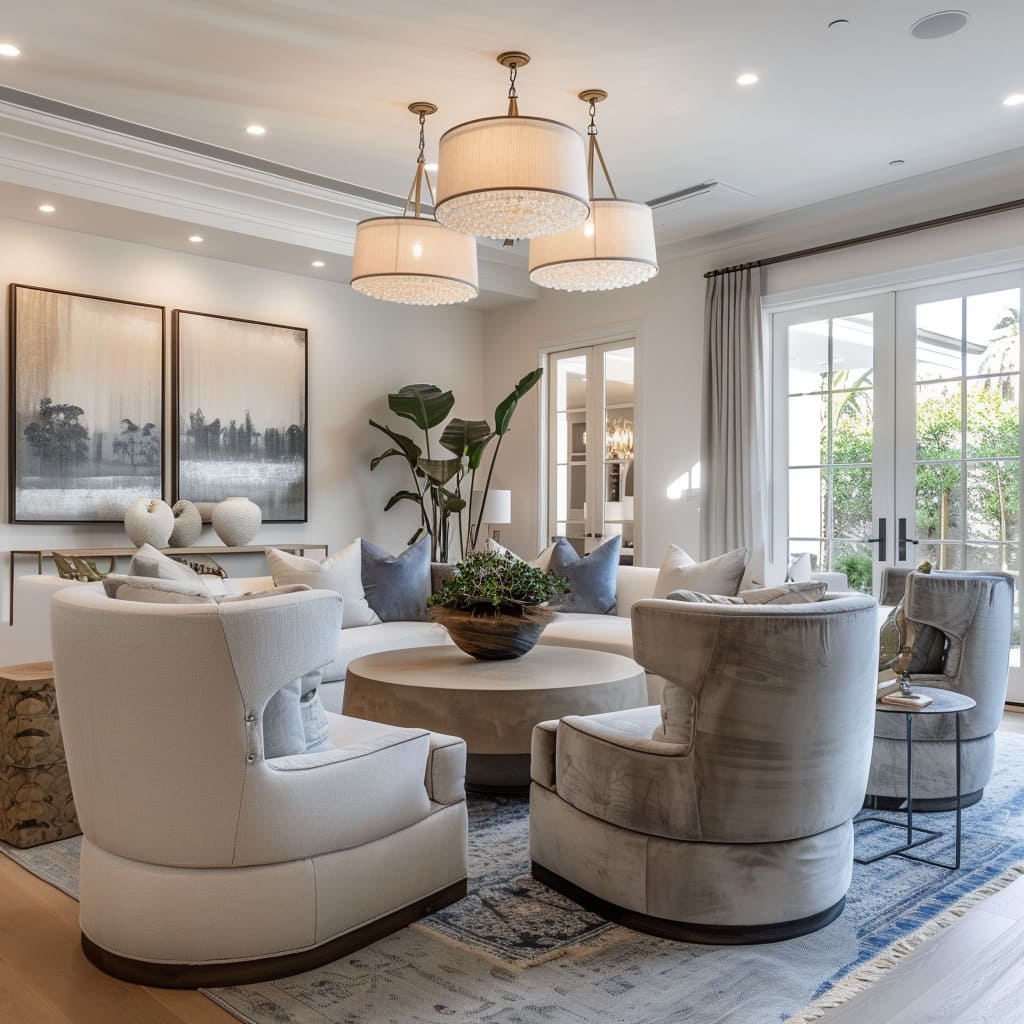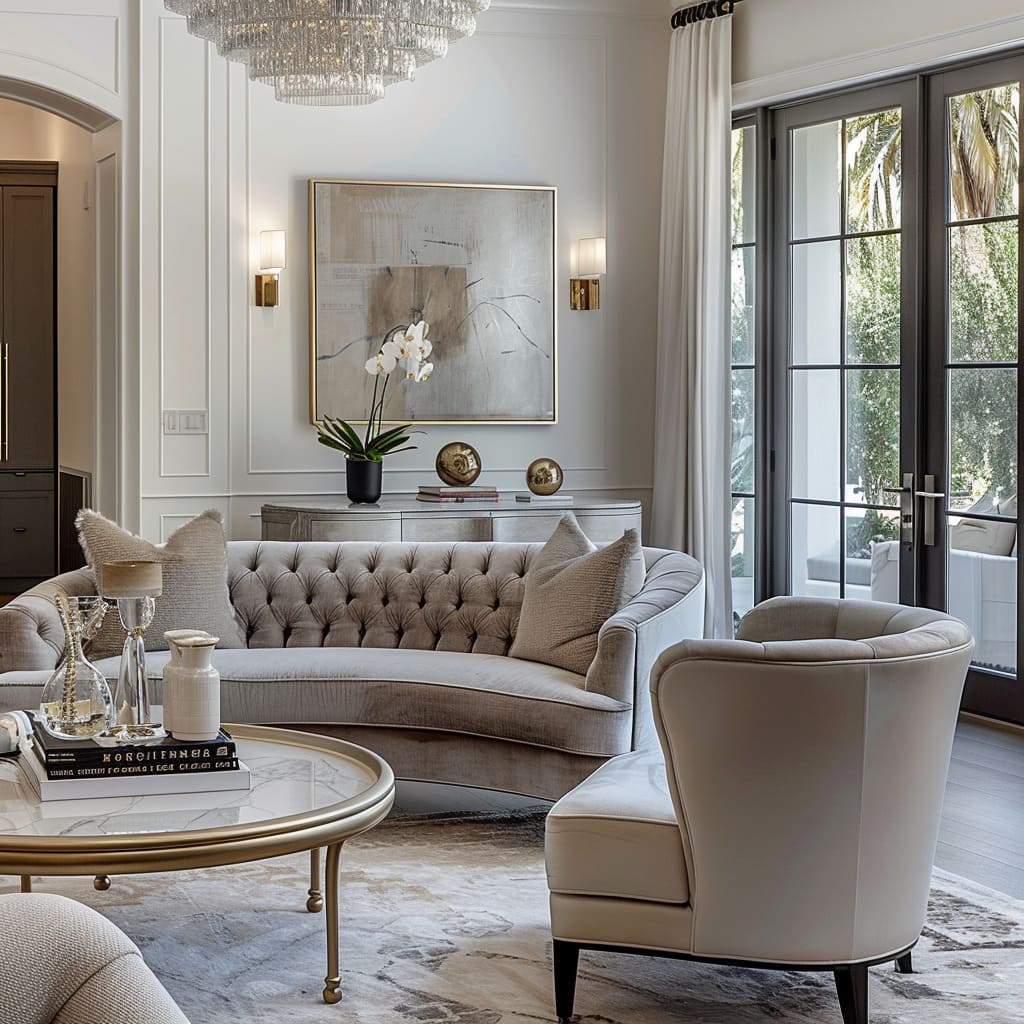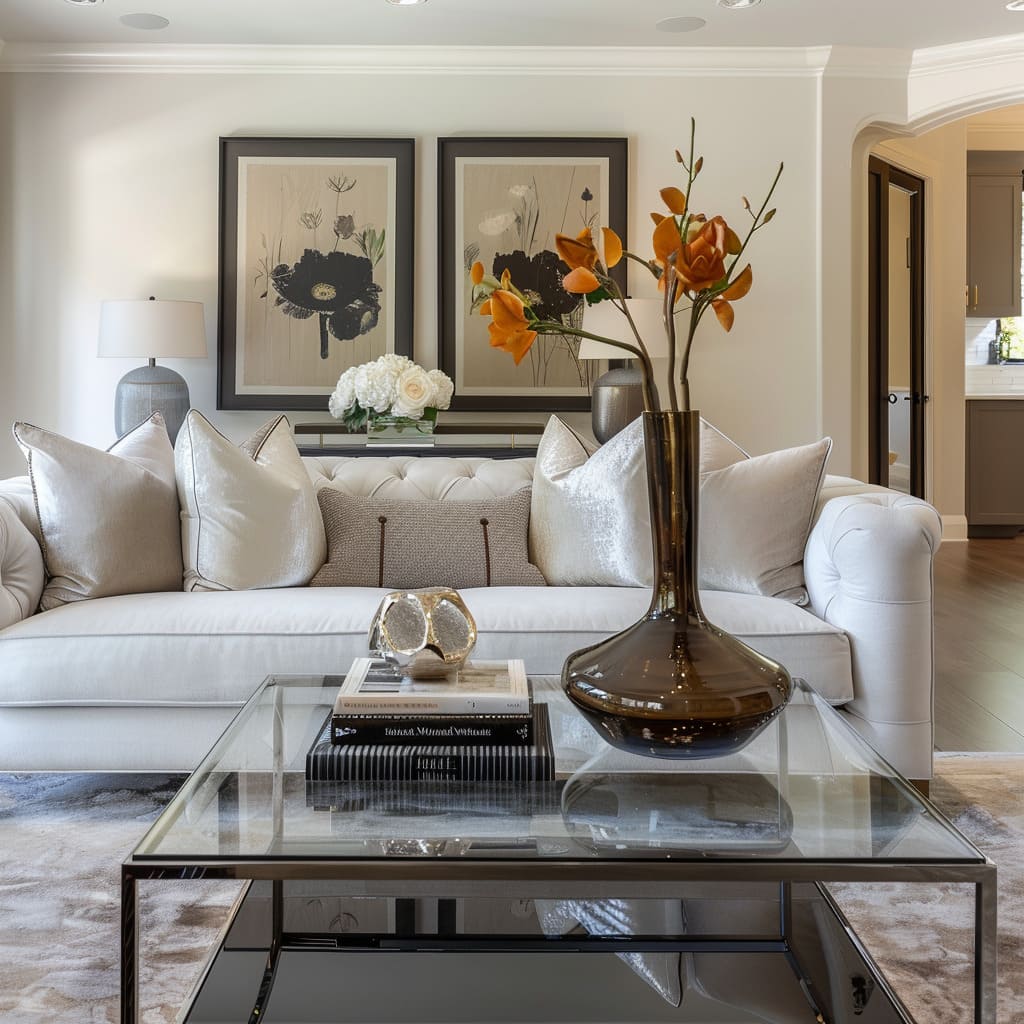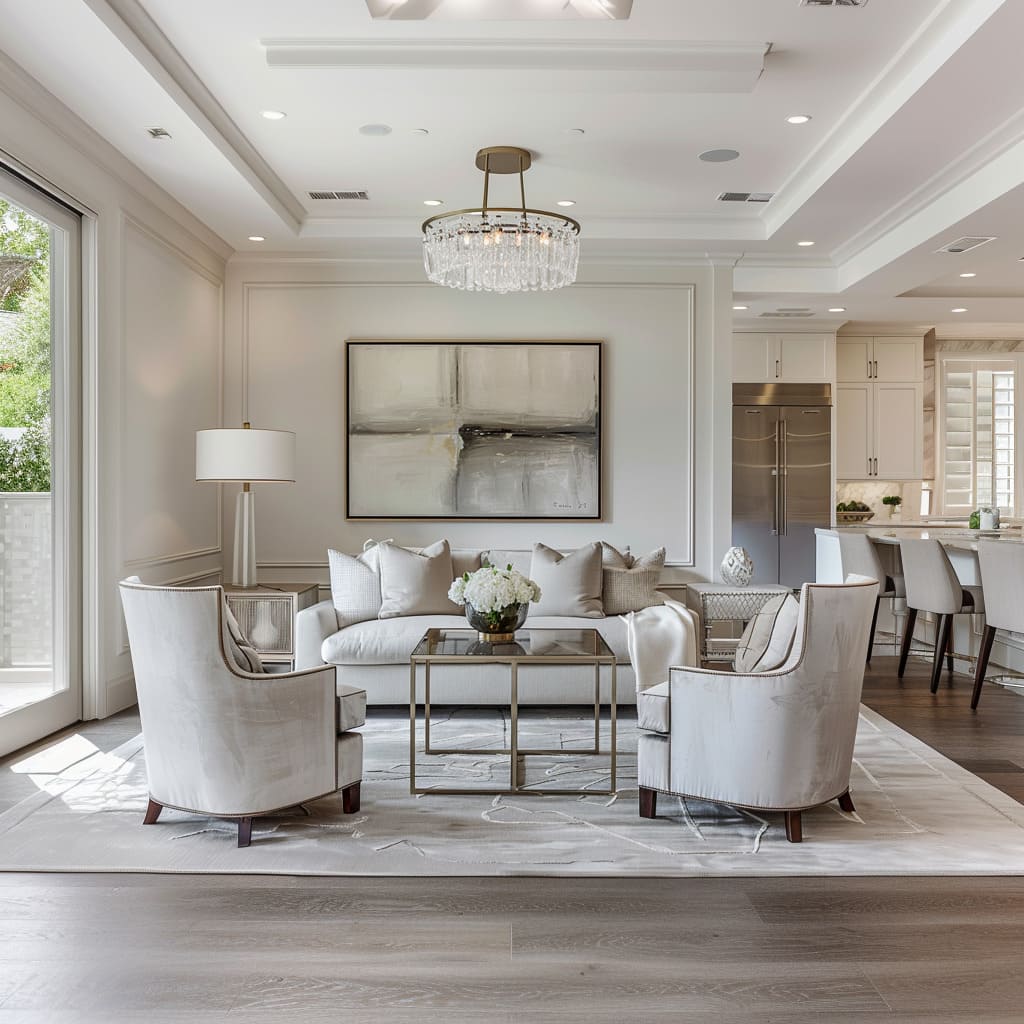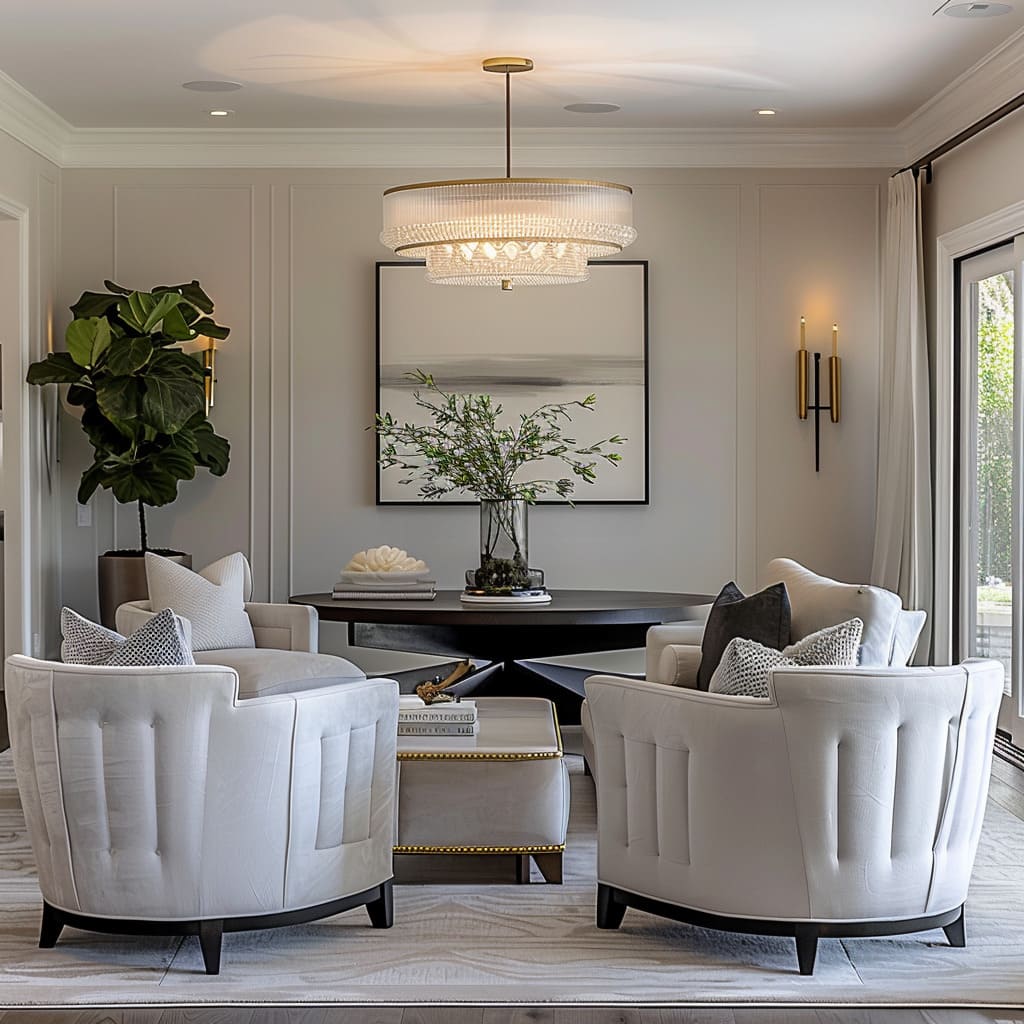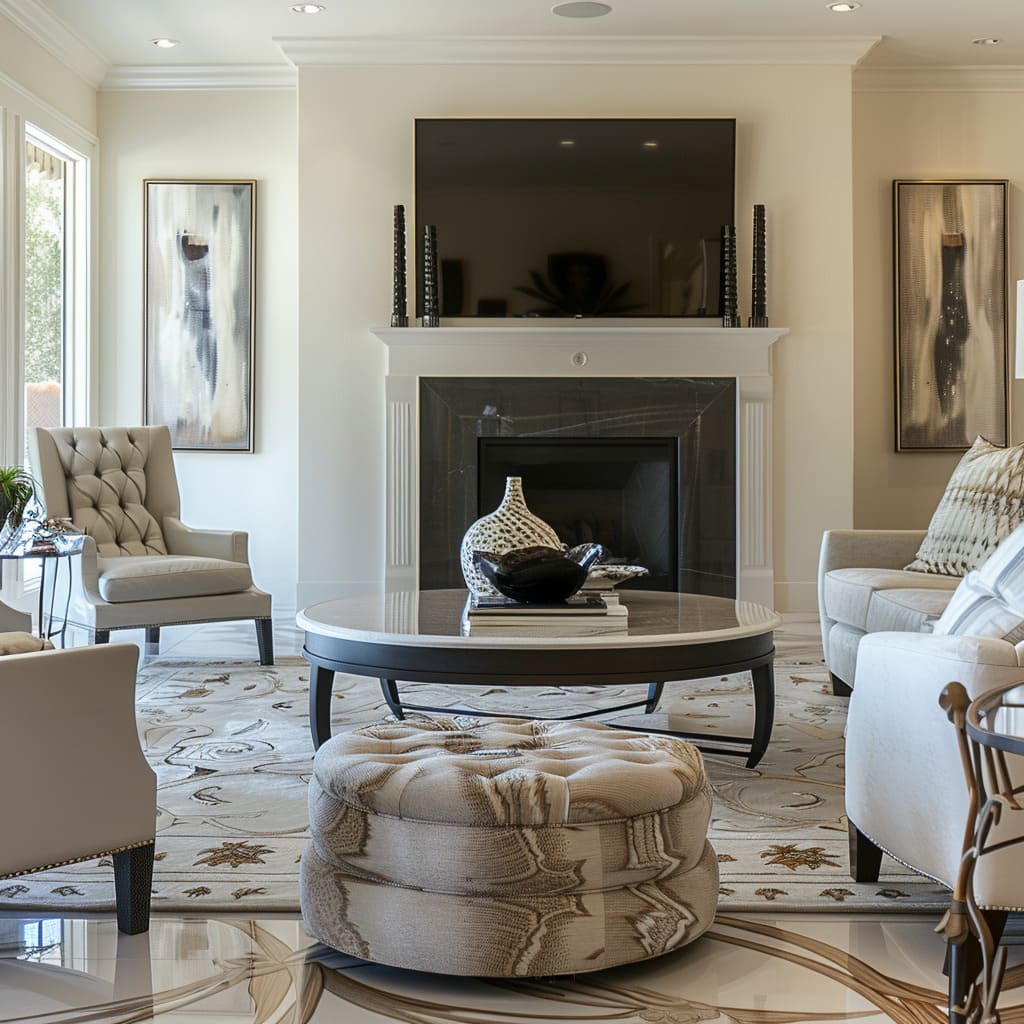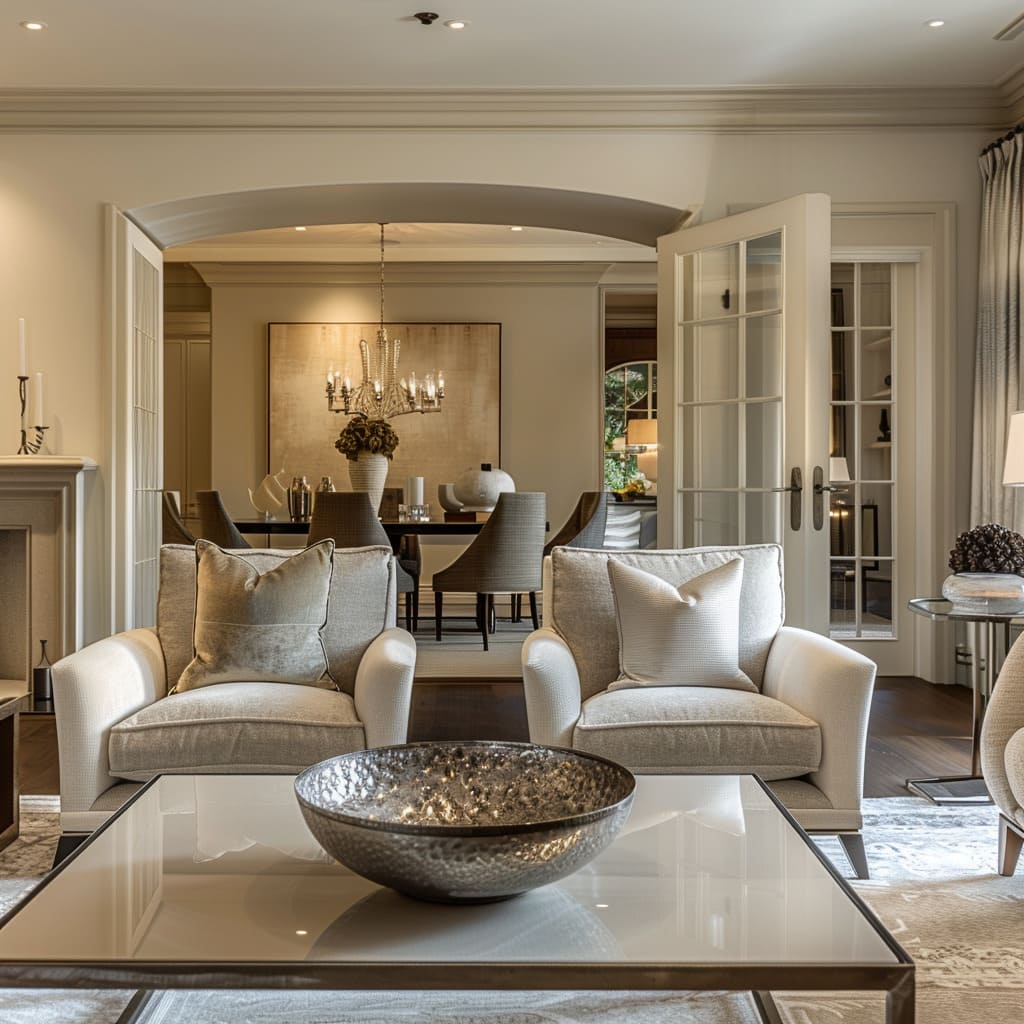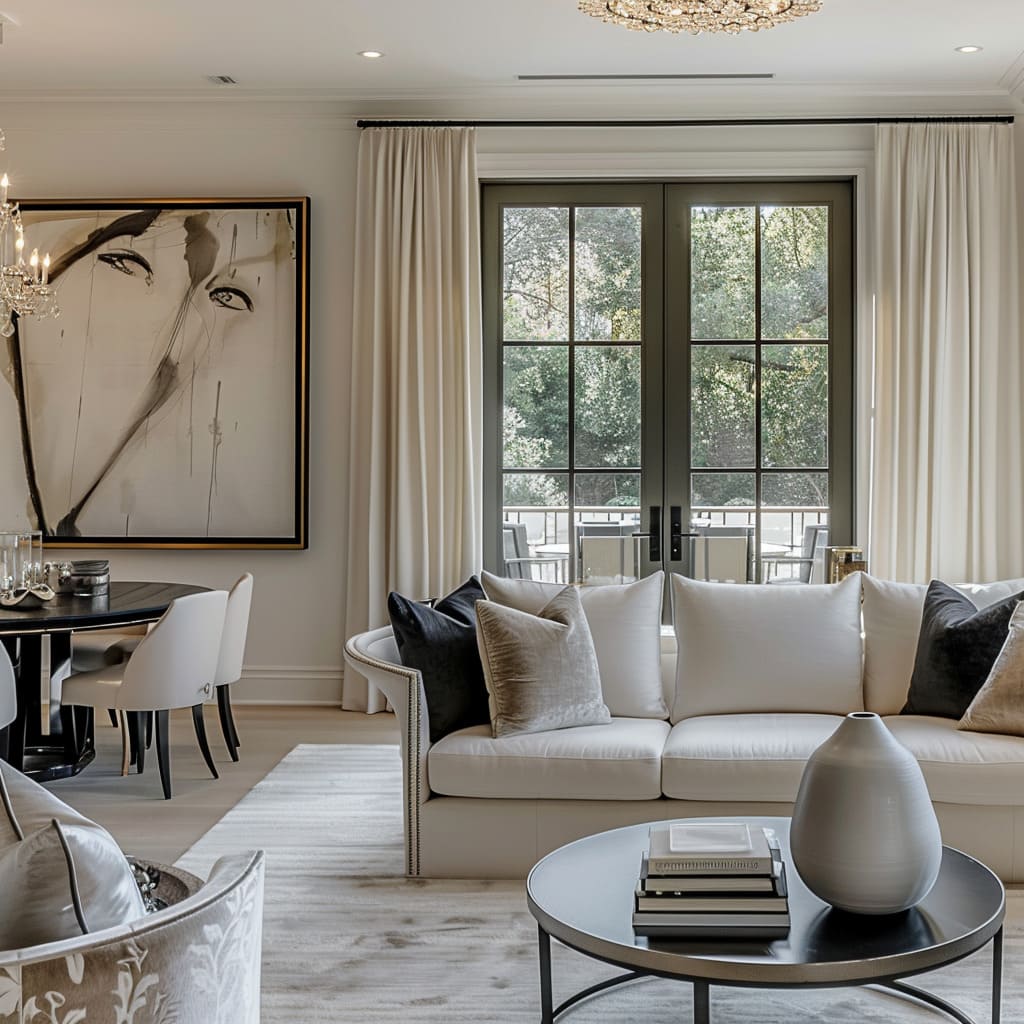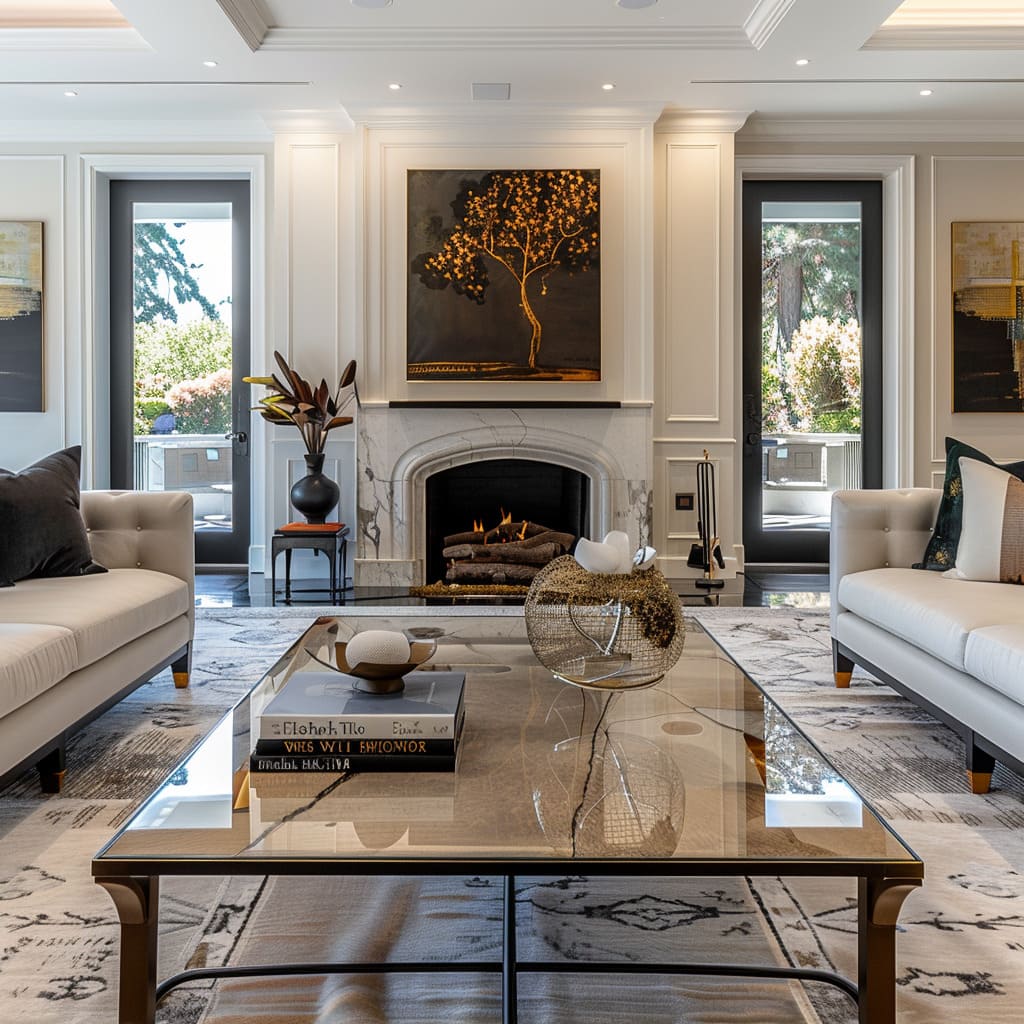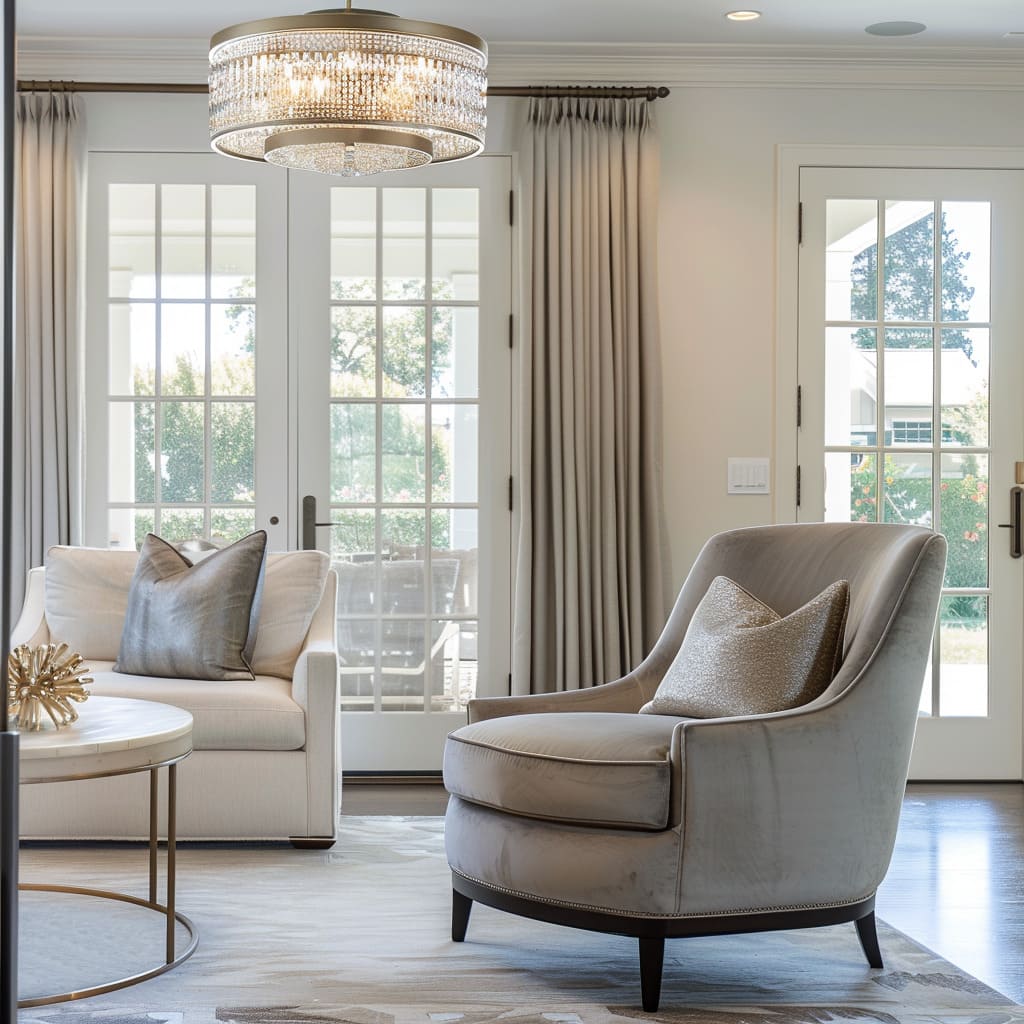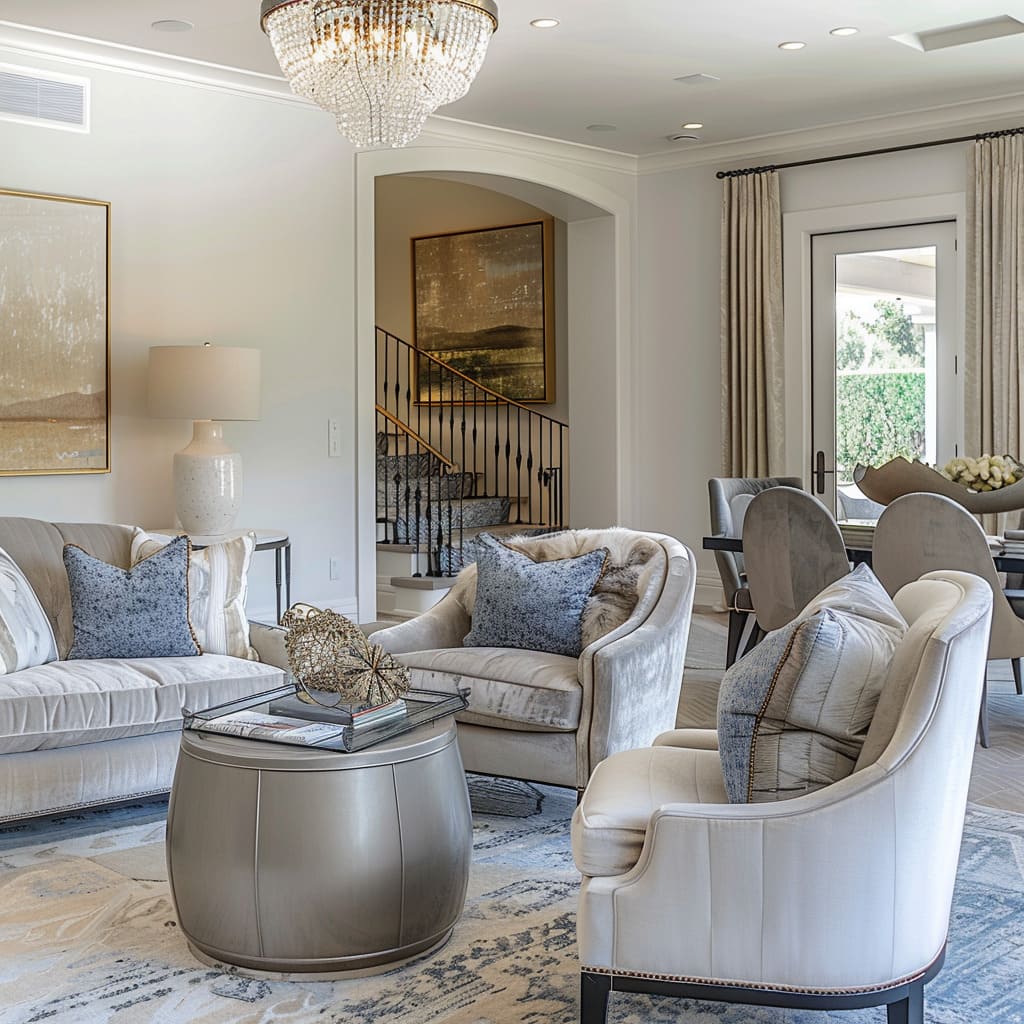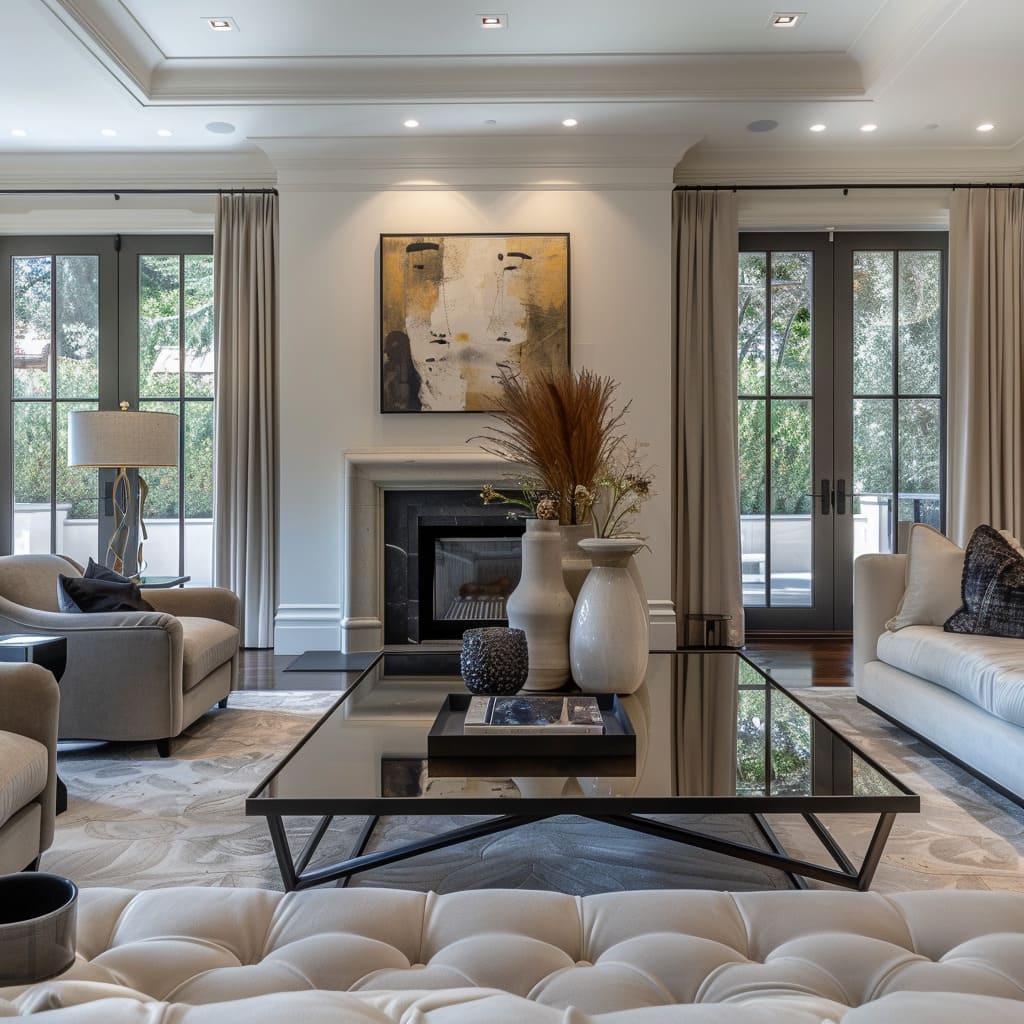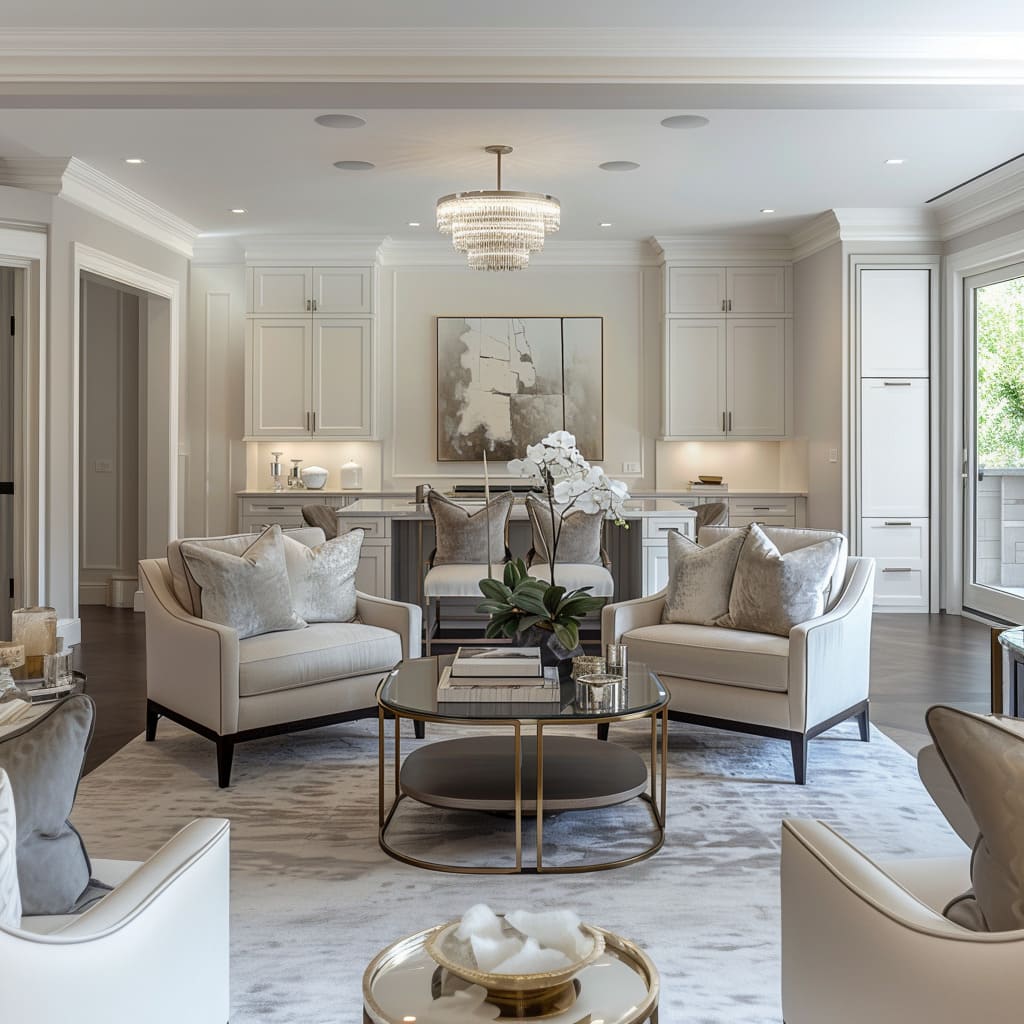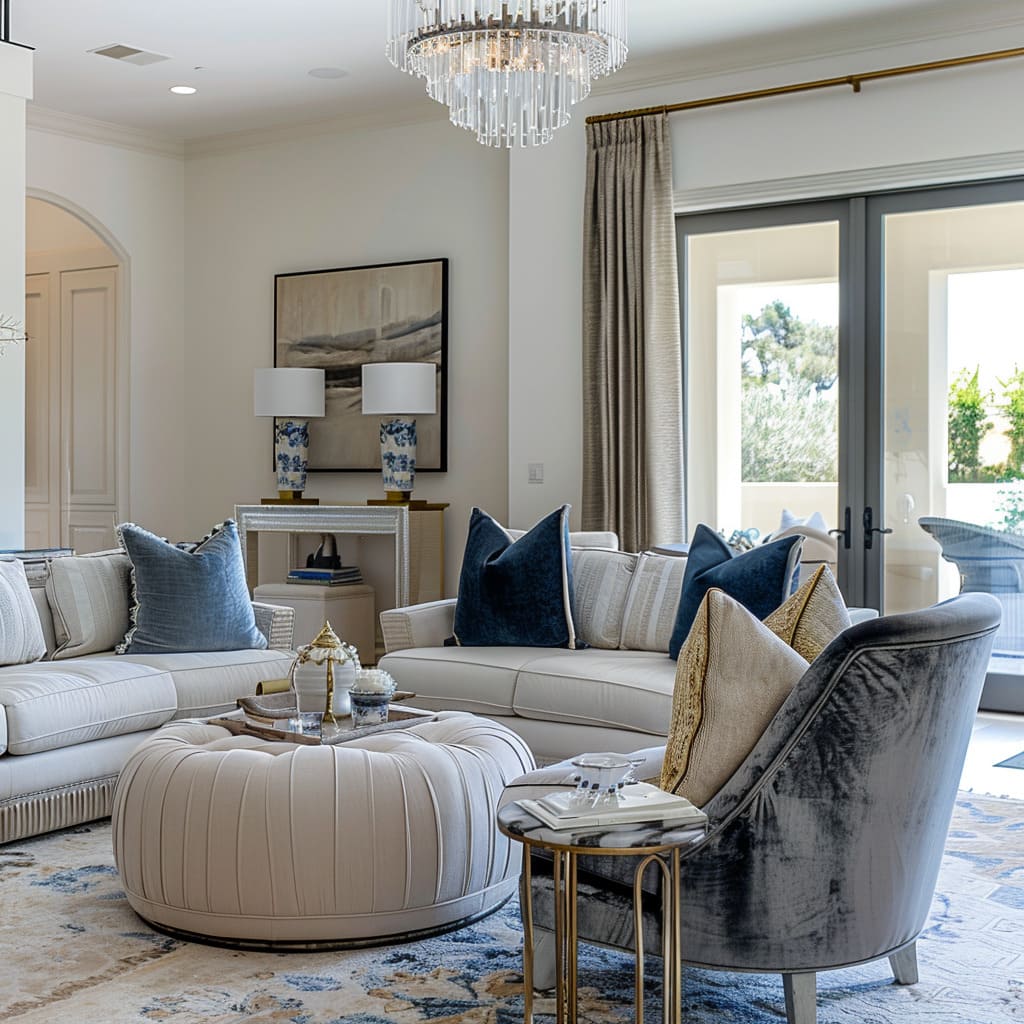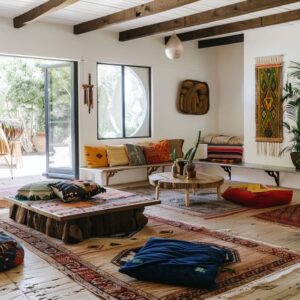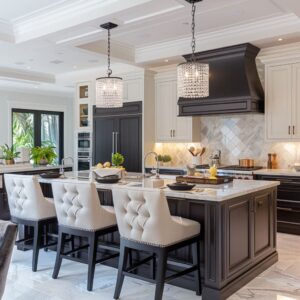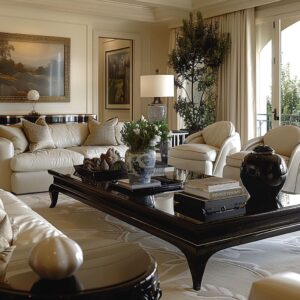Transitional style is a design approach that blends traditional and contemporary elements, creating spaces that are both timeless and modern. It strikes a perfect balance, combining the elegance of classic designs with the clean lines and understated appeal of contemporary aesthetics. This fusion results in interiors that feel cohesive and sophisticated.
The importance of blending traditional and contemporary elements cannot be overstated. It allows homeowners to retain the charm and character of their existing spaces while infusing them with fresh, updated looks. This balance is particularly appealing in a transitional style living room, where the warmth and comfort of traditional pieces meet the sleek simplicity of modern design.
The objective of upgrading a traditional American living room with transitional style decor is to transform the space into a sophisticated, inviting area that reflects both past and present influences. By carefully selecting furniture, decor, and finishes, one can achieve a harmonious look that feels both comfortable and stylish. The goal is to create a living room that seamlessly integrates the old with the new, offering a space that is welcoming and aesthetically pleasing.
Understanding Transitional Style
Transitional interior design is defined by its ability to merge traditional and contemporary styles into one cohesive look. This design style takes the best of both worlds, allowing homeowners to enjoy the familiarity of classic elements while embracing modern updates. Key characteristics of transitional decor include a balanced mix of classic and modern furnishings, a neutral color palette, and a thoughtful combination of textures.
Furniture pieces often feature clean lines but with a nod to traditional detailing, such as tufted sofas or chairs with curved arms. The color palette typically consists of soft neutrals—beiges, whites, and greys—that create a calming and versatile backdrop.
Textures play a significant role in transitional home decor, adding depth and interest to the space. Mixing materials like wood, metal, glass, and fabric helps achieve a layered look that is both inviting and visually dynamic. For example, a plush sofa might be paired with a sleek glass coffee table, while a classic wooden cabinet might be accented with modern metal hardware. In essence, transitional style decor offers a flexible and appealing way to upgrade a traditional American living room. By focusing on the seamless integration of classic and contemporary elements, one can create a space that is both timeless and current, providing a comfortable yet stylish environment for everyday living.
Assessing the Traditional Living Room
Analyzing Existing Features and Layout
When upgrading a traditional American living room to embrace a transitional design style, the first step is to thoroughly assess the existing features and layout. This involves taking a detailed look at the room’s architecture, identifying the elements that define its traditional character. Key features to examine include the arrangement of furniture, the flow of the space, and the architectural details such as ceiling height, windows, and door placements. Understanding these components helps in making informed decisions about which traditional elements to retain and how to incorporate new pieces effectively.
Identifying Traditional Elements to Retain
Certain traditional elements are worth preserving as they add character and charm to the living room. For instance, a classic fireplace can serve as a beautiful focal point in a transitional style interior design. The fireplace’s mantel can be updated with modern accessories, but its fundamental structure should remain to maintain a sense of history and continuity.
Similarly, intricate moldings and trims on walls and ceilings contribute to the room’s traditional feel and should be kept intact. These details can be painted in neutral tones to seamlessly blend with the transitional interior decor. Other elements like vintage hardwood floors and large, well-placed windows provide warmth and natural light, essential components of home decor transitional style. Retaining these features ensures that the room maintains its traditional roots while being enhanced with contemporary updates.
Determining Aspects That Need Updating
Once the traditional elements to be retained are identified, the next step is to determine which aspects need updating to achieve a transitional interior style. Furniture is often the primary area that requires attention. Replacing bulky, ornate pieces with sleek, modern designs can significantly transform the space. Opt for sofas and chairs with clean lines, neutral fabrics, and subtle detailing.
This approach helps to create a balanced look that is neither too traditional nor overly modern.
Decor items also play a crucial role in the transformation. Traditional decor pieces like heavy drapes and ornate lamps can be replaced with lighter, more contemporary alternatives. For example, introducing minimalist art pieces, modern lighting fixtures, and streamlined window treatments can freshen up the space while adhering to the principles of transitional interior decor. Additionally, consider updating the color palette to incorporate neutral tones that are characteristic of transitional interior style. Soft greys, beiges, and whites create a versatile backdrop that allows both traditional and contemporary elements to shine.
These colors can be applied to walls, furnishings, and accessories, providing a cohesive look that ties the entire room together.
By carefully analyzing the existing features, retaining key traditional elements, and updating specific aspects, a traditional living room can be successfully upgraded to reflect a transitional style interior design. This balanced approach ensures that the room remains inviting and comfortable, while also embracing modern aesthetics.
Furniture Selection
Sofa and Seating
When selecting furniture for a transitional living room style, opting for neutral-colored sofas with classic shapes and modern fabrics is key. A perfect example of this is a cream-colored tufted sofa with rolled arms. This type of sofa provides a nod to traditional design while its neutral hue and sleek fabric make it contemporary. Adding plush cushions in various textures, such as velvet and silk, and in colors like silver and charcoal, enhances the sofa’s comfort and adds depth to the room.
These cushions not only serve as cozy additions but also as subtle accents that tie the room’s decor together.
Coffee Tables
The coffee table is another essential piece in transitional style interiors. Choosing sleek designs crafted from luxurious materials can elevate the overall look. For instance, round coffee tables with white marble tops and gold bases blend traditional and modern elements seamlessly. These tables offer functionality and style, providing a surface for decor items while adding a touch of elegance to the space.
Their reflective surfaces can make the room feel more open and airy, contributing to the transitional living room furniture aesthetic.
Additional Seating
Incorporating additional seating, such as accent chairs, can introduce vibrant colors and contemporary shapes to the living room. A striking example would be burnt orange velvet armchairs. These chairs not only add a pop of color but also offer a modern contrast to the more traditional pieces in the room. The rich texture of the velvet enhances the luxurious feel, while the bold color ensures the chairs stand out as statement pieces.
Balancing the room with a mix of textures and finishes is crucial in transitional style home decor. For instance, combining the soft fabric of the sofa and chairs with the hard surfaces of the marble-topped coffee tables creates a harmonious blend of materials. This balance helps in achieving a cohesive look that is both inviting and stylish.
By thoughtfully selecting and arranging these pieces, the living room can achieve the perfect transitional look. Each furniture item, from the transitional style sofa to the chic coffee tables and vibrant accent chairs, plays a role in merging the old with the new. The result is a space that feels balanced, comfortable, and elegantly updated.
Enhancing with Decor
Throw Pillows
One of the simplest yet most effective ways to enhance a modern transitional living room is by using throw pillows. Mixing shades and textures adds depth and character to the space. An assortment of throw pillows in silver, grey, and charcoal can create a visually interesting and cohesive look. These colors complement a neutral sofa while adding layers of sophistication.
The key is to choose pillows in various textures such as velvet, silk, and linen, ensuring both comfort and visual appeal. The mix of materials not only invites touch but also catches the light differently, creating a dynamic and engaging seating area.
Centerpieces and Accessories
Centerpieces and accessories are crucial for adding personality and style to a transitional modern living room. Elegant vases filled with fresh or faux flowers can serve as stunning focal points. For example, a polished silver vase with white orchids can bring a touch of nature and elegance into the space. The sleek, reflective surface of the vase complements both traditional and contemporary elements in the room.
In addition to vases, decorative trays, sculptures, and coffee table books can elevate the room’s sophistication. A well-placed tray can organize small items while adding a decorative touch. Sculptures introduce artistic flair, and coffee table books provide not only reading material but also a stylish statement. These accessories, when thoughtfully chosen and arranged, contribute to the room’s overall aesthetic, enhancing its transitional home design.
Wall Art
Incorporating large-scale, framed artwork is another effective way to enhance a transitional modern style. Abstract paintings with muted tones and modern frames can balance traditional walls with contemporary art.
This blend is essential in creating a harmonious look in a transitional modern living room. Large pieces of art draw the eye and can serve as conversation starters, adding depth and interest to the room.
The frames should be simple yet stylish, complementing the room’s existing decor without overpowering it. For example, a large abstract painting in shades of beige, grey, and soft blue can provide a soothing backdrop while making a bold statement. The artwork’s colors can tie together various elements in the room, ensuring a cohesive and polished look. In a transitional bedroom design, similar principles apply. Mixing traditional elements like classic furniture pieces with modern accessories and decor can create a serene and stylish retreat.
For instance, incorporating contemporary art above a traditional dresser or using modern lighting fixtures alongside vintage bedside tables can seamlessly blend old and new, achieving a balanced and inviting space.
By carefully selecting and integrating throw pillows, centerpieces, accessories, and wall art, a living room can be transformed into a space that perfectly embodies transitional home design. Each element plays a vital role in creating a room that is both sophisticated and inviting, blending the best of traditional and modern styles.
Lighting
Ambient Lighting
Ambient lighting is the foundation of any well-lit room, providing general illumination that ensures the space is comfortably lit. In a contemporary transitional living room, installing recessed ceiling lights can offer even, unobtrusive lighting throughout the area. These lights are sleek and modern, blending seamlessly with the ceiling to maintain the room’s clean lines and open feel. Enhancing natural light is equally important. Large windows can flood the room with daylight, making it feel airy and welcoming.
To maximize this natural light, opt for light curtains that allow sunlight to filter through while maintaining privacy. These curtains should be in neutral tones to complement the room’s color palette and enhance the overall aesthetic.
Statement Fixtures
Adding statement fixtures like chandeliers can elevate the room’s elegance and sophistication. Chandeliers with classic designs that incorporate modern elements are perfect for a modern transitional interior design. For example, a chandelier with cascading crystals combines traditional luxury with contemporary flair, creating a stunning focal point in the room. This type of fixture complements the opulent feel of transitional style living room furniture and adds a layer of visual interest to the ceiling.The chandelier’s reflective crystals can also help distribute light more evenly, enhancing the room’s ambiance. It’s important to choose a fixture that matches the scale of the room and ties in with other decor elements, ensuring a cohesive look that defines transitional decor.
Accent Lighting
Accent lighting plays a crucial role in creating a balanced and layered lighting scheme. Using table lamps with modern bases and traditional shades can add both function and style to the room.
For instance, a lamp with a gold base and a white drum shade offers a mix of classic and contemporary elements, fitting perfectly within the transitional style.
These lamps can be placed on transitional style end tables flanking the sofa or next to reading chairs to provide targeted lighting for reading or other tasks. The combination of a sleek, modern base and a more traditional shade brings together the best of both worlds, contributing to the room’s overall harmony.By carefully integrating ambient, statement, and accent lighting, a transitional living room can achieve a well-rounded and inviting atmosphere. Each type of lighting serves a distinct purpose, working together to highlight the room’s design features and create a comfortable environment. This approach ensures that the lighting not only meets practical needs but also enhances the aesthetic appeal of the space, making it a perfect example of transitional home decor.
Flooring and Rugs
Hardwood Floors
One of the foundational elements in transitional home interior design is the choice of flooring. Maintaining rich, dark hardwood floors can provide a sense of warmth and grounding to the room. These floors offer a timeless appeal that bridges traditional and contemporary styles. The deep tones of dark hardwood add a layer of sophistication and elegance, which is essential in creating a balanced transitional space.
To enhance the hardwood floors and define different areas within the living room, adding large area rugs with subtle patterns is a great idea. Rugs in soft greys and beiges can anchor the seating area, providing a neutral backdrop that complements the room’s color palette. These neutral tones blend seamlessly with the hardwood floors, creating a cohesive look that ties the entire room together. The addition of area rugs also introduces a sense of comfort and coziness, making the space more inviting.
Rugs
When selecting rugs for a transitional design, it’s important to choose designs that complement the overall color palette and add texture to the space. Subtle geometric patterns are an excellent choice for achieving this balance. These patterns can add visual interest without overwhelming the room’s decor, aligning well with transitional style decorating ideas. For example, a rug with a delicate geometric design in muted colors can enhance the aesthetic of the living room while providing a soft surface underfoot. The texture and pattern of the rug can complement the smooth finish of the hardwood floors and the plush fabrics of the furniture, creating a layered and visually appealing space.
This approach ensures that the rugs serve both a functional and decorative purpose, enhancing the overall look and feel of the room.
Incorporating these transitional design ideas into the flooring and rugs can significantly impact the room’s ambiance. The right combination of rich hardwood floors and thoughtfully selected rugs can elevate the entire space, making it feel both sophisticated and comfortable. These elements are crucial in achieving a successful transitional home interior design, where every detail contributes to a harmonious and inviting environment. To complete the look, consider how these flooring choices interact with other elements in the room, such as transitional style coffee tables and seating arrangements. The seamless integration of flooring and furniture helps create a unified design that reflects the elegance and versatility of transitional style interiors.
By focusing on these details, you can create a living room that is not only beautiful but also functional and welcoming.
Architectural Details
Crown Molding and Baseboards
Incorporating architectural details is key to achieving a living room transitional style interior design. Crown molding and baseboards play a crucial role in adding depth and sophistication to the space. Preserving or enhancing these traditional elements helps maintain a sense of history and elegance in the room. Crown molding, with its intricate design, draws the eye upward, making the ceiling appear higher and the room more spacious.
Baseboards, on the other hand, provide a finished look to the walls and protect them from scuffs and damage. Both features can be painted in a neutral color to blend seamlessly with the overall decor, ensuring they complement rather than overpower the other elements in the room.
Fireplace
A fireplace often serves as the focal point in a living room, and in a transitional design, retaining classic mantels with clean lines is essential. These mantels offer a touch of traditional charm while providing a backdrop for modern decor items. Enhancing the fireplace with contemporary accessories can bridge the gap between old and new. For example, placing gold candlesticks with glass hurricane shades on the mantel can introduce a modern yet elegant touch.
These items add a hint of glamour and reflect light beautifully, enhancing the room’s ambiance. The fireplace thus becomes a central feature that embodies the essence of contemporary transitional interior design.
Built-in Cabinets
Built-in cabinets are not only practical for storage but also add architectural interest to the room. Incorporating storage solutions with contemporary finishes can elevate the overall look. Dark-finished cabinets with glass doors and gold trim are a perfect example. These cabinets offer a striking contrast against neutral walls and provide a sophisticated storage option.
The glass doors allow for the display of elegant decorative items, such as fine china, books, or art pieces, adding a personal touch to the space. Incorporating built-in cabinets with modern finishes aligns with modern transitional living room ideas. These cabinets can house a variety of items, making them versatile and functional. The addition of gold trim adds a touch of luxury, enhancing the room’s overall aesthetic. By displaying carefully selected decorative items, the cabinets become a feature in their own right, contributing to the room’s sophisticated yet welcoming atmosphere.
Integrating Architectural Details
When integrating these architectural details, it’s important to consider how they interact with other design elements in the room. Crown molding and baseboards should seamlessly blend with the flooring and wall colors. The fireplace and built-in cabinets should complement the furniture and decor, ensuring a cohesive look. These elements collectively contribute to the overall elegance and functionality of the space, making it a prime example of living room transitional style interior design.
By focusing on these architectural details, you can create a space that is both timeless and contemporary. The careful preservation and enhancement of traditional elements, combined with modern updates, result in a room that feels balanced and sophisticated. This approach not only enhances the visual appeal but also adds to the comfort and functionality of the living room, making it a perfect blend of old and new, ideal for elegant transitional living rooms. Incorporating rustic transitional decor, such as distressed wood elements or vintage-inspired accessories, can add warmth and character to the space. These touches provide a contrast to the sleek finishes and modern decor, creating a harmonious balance.
This blend of styles ensures that the living room feels inviting and well-curated, reflecting a thoughtful approach to transitional home design.
Integrating Natural Elements
Greenery
Integrating natural elements into your transitional decor living room is essential for adding a touch of freshness and vibrancy. One effective way to achieve this is by incorporating potted plants. Greenery not only enhances the aesthetic appeal of the space but also contributes to a healthier indoor environment. A large fiddle leaf fig tree, for example, can be an excellent addition to a transitional design living room.
Its broad, glossy leaves and tall stature make it a striking focal point, bringing a sense of nature indoors. The green hues of the plant balance the neutral tones often found in transitional decor, creating a harmonious and inviting atmosphere. Potted plants can be strategically placed throughout the room to ensure they complement the existing decor. Smaller plants can be placed on side tables or shelves, while larger plants can occupy corners or spaces near windows where they can thrive in natural light.
This integration of greenery helps to soften the lines of the furniture and adds a dynamic, living element to the room.
Fresh Flowers
Fresh flowers or high-quality faux arrangements are another way to bring natural beauty into your living space. Flowers add color, texture, and a touch of elegance to any room. Using fresh or faux arrangements in elegant vases can significantly enhance the visual appeal of your transitional decor. For instance, white orchids in polished silver vases can introduce a sense of sophistication and tranquility.
The sleek, reflective surface of the vase complements the modern elements of the room, while the delicate blooms of the orchids add a touch of natural grace. These floral arrangements can be placed on coffee tables, mantels, or console tables to draw attention and add visual interest. The choice of flowers and vases should reflect the overall color scheme and style of the room. For a transitional design living room, neutral or softly colored flowers are ideal, as they blend seamlessly with the decor without overpowering it.
In addition to orchids, other suitable flowers for a transitional living room include lilies, hydrangeas, and roses. These flowers can be arranged in simple, elegant vases to create a refined look. Faux arrangements are also a practical choice, as they require less maintenance while still offering the beauty of fresh blooms.
Balancing the Interior with Nature
Balancing the interior with natural elements is a key aspect of defining transitional decorating style. Incorporating plants and flowers helps to create a seamless connection between the indoors and the natural world. This balance enhances the room’s ambiance, making it feel more grounded and serene. Natural elements like plants and flowers can be complemented by other organic materials, such as wooden furniture or stone accessories. This approach adds texture and depth to the room, creating a layered, cohesive look.
By thoughtfully integrating natural elements, you can achieve a transitional decor living room that feels both elegant and inviting.
In summary, adding potted plants and fresh or faux flower arrangements are simple yet effective ways to bring natural beauty into your living space. These elements not only enhance the visual appeal of the room but also contribute to a healthier and more balanced environment. By incorporating greenery and flowers, you can create a living room that exemplifies the best of transitional style, blending traditional charm with contemporary elegance.
Cohesive Design Flow
Open Plan Living
Creating a visual flow between the living and dining areas is essential in transitional interior design. An open plan layout allows for a seamless connection between spaces, promoting a sense of continuity and harmony. To achieve this, it’s important to maintain a consistent color scheme and decor style throughout both areas. For example, if the living room features a palette of soft greys, beiges, and hints of metallics, the dining area should reflect these colors to ensure a cohesive look.
Using similar materials and finishes also helps in creating a unified aesthetic. If the living room has a mix of polished wood and glass elements, incorporating these materials into the dining room’s furniture and decor will strengthen the visual connection between the spaces. This approach not only enhances the overall flow but also makes each area feel like a natural extension of the other.
Coordinated Decor
Coordinated decor plays a crucial role in maintaining a cohesive design flow. Using matching or complementary pieces in adjacent rooms ensures that each space feels connected while retaining its own identity. For instance, a chandelier in the dining room that echoes the style of the living room’s lighting fixture can create a harmonious link between the two areas. This kind of thoughtful coordination underscores the unified design vision.
Furniture and accessories should also be chosen with this coordination in mind. Transitional style living room furniture should complement the pieces in the dining area. For example, if the living room features a tufted sofa with rolled arms, selecting dining chairs with subtle tufting or similar curved lines can reinforce the transitional decor theme. Similarly, decorative elements such as throw pillows, rugs, and artwork should reflect the overall color palette and style of both rooms.
Conclusion
Upgrading a traditional living room with transitional style decor involves blending classic and modern elements to create a sophisticated yet inviting space. Key points to remember include maintaining rich, dark hardwood floors, incorporating plush area rugs with subtle patterns, and enhancing the room with a mix of traditional and contemporary architectural details. Lighting plays a pivotal role in setting the ambiance, with a combination of recessed ceiling lights, statement chandeliers, and accent lamps creating a balanced scheme.
Integrating natural elements like potted plants and fresh flowers adds a touch of freshness and vibrancy, helping to balance the interior with nature. Ensuring a cohesive design flow through an open plan layout and coordinated decor in adjacent rooms further enhances the space’s harmony.
Encouraging readers to experiment with textures, colors, and decor will help them achieve their desired look in a transitional style living room. By blending classic and modern elements thoughtfully, homeowners can create spaces that are both elegant and comfortable, reflecting the best of transitional interior design.

